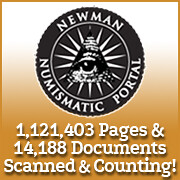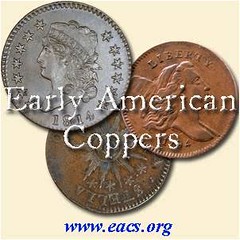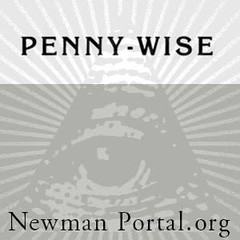
About UsThe Numismatic Bibliomania Society is a non-profit organization devoted to the study and enjoyment of numismatic literature. For more information please see our web site at coinbooks.org SubscriptionsThose wishing to become new E-Sylum subscribers (or wishing to Unsubscribe) can go to the following web page link MembershipThere is a membership application available on the web site Membership Application To join, print the application and return it with your check to the address printed on the application. Print/Digital membership is $40 to addresses in the U.S., and $60 elsewhere. A digital-only membership is available for $25. For those without web access, write to: Terry White, Treasurer AsylumFor Asylum mailing address changes and other membership questions, contact Terry at this email address: terrywhite5475@yahoo.com SubmissionsTo submit items for publication in The E-Sylum, just Reply to this message, or write to the Editor at this address: whomren@gmail.com BUY THE BOOK BEFORE THE COINSale Calendar |
- WAYNE'S WORDS: THE E-SYLUM AUGUST 6, 2017
- 2017 NLG WRITERS’ COMPETITION RESULTS
- NEW BOOK: BRITISH HISTORICAL MEDALS OF THE 17TH CENTURY
- NEW BOOK: STRIKING GOLD IN ALASKA, 6TH EDITION
- NEW BOOK: A NUMISMATIC HISTORY OF CONGO/ZAïRE
- NEW BOOK: DECCAN SULTANATE COINS
- NEWMAN PAPERS REVEAL 1792 U.S. MINT DOCUMENT
- HARLEY FREEMAN COLONIAL PAPER MONEY INVENTORY
- A LIST OF COIN PERIODICAL WEB SITES
- NOVA CONSTELLATIO QUINT STRUCK AS AMERICAN COIN
- QUERY: MYSTERY JAPANESE ITEMS
- MORE ON THE MYSTERY "SILK TRADE TOKEN"
- NOTES FROM E-SYLUM READERS: AUGUST 6, 2017
- THE LONG AND THE SHORT OF THE CCAC
- 2018 AMERICA THE BEAUTIFUL QUARTER DESIGNS
- VOCABULARY TERM: FOUNDING DATE
- ARTHUR WHITE WESTHORPE (1869-1927)
- REV. JUSTUS DOOLITTLE (1824-1880)
- PCGS COINFACTS DEALER HALL OF FAME INDUCTEES
- THE NICHOLSON AND WILSON HALF DIME TOKENS
- COINS FROM THE WOODWORK AT 1901 EXPOSITION
- ARCHIVES INTERNATIONAL SALE 44 ANNOUNCED
- WAYNE'S NUMISMATIC DIARY: AUGUST 6, 2017, PART 1
- WAYNE'S NUMISMATIC DIARY: AUGUST 6, 2017, PART 2
- WAYNE'S NUMISMATIC DIARY: AUGUST 6, 2017, PART 3
- ARCHAEOLOGISTS FIND PICTISH REMAINS
- ASTRONOMER MARIA MITCHELL’S GOLD MEDAL
- A TRIO OF CIVIL WAR ITEMS FROM 1861
- MORE ON THE 1958 JUDAEA LIBERATA MEDAL
- TRUMP AWARDS VIETNAM SOLDIER'S MEDAL OF HONOR
- GOLD COAST GUARD LIFESAVING MEDAL AWARDED
- WHAT MONEY SAYS ABOUT PEOPLE
Click here to access the complete archive
To comment or submit articles, reply to whomren@gmail.com
Content presented in The E-Sylum is not necessarily researched or independently fact-checked, and views expressed do not necessarily represent those of the Numismatic Bibliomania Society.
WAYNE'S WORDS: THE E-SYLUM AUGUST 6, 2017
 New subscribers this week include: Don Simon, courtesy David Hendin, Edwin J. Morrow, and Al Flyr, courtesy of Terry Freed of Des Moines, Iowa; and Pete Conroy. Welcome aboard! We now have
3,268 subscribers.
New subscribers this week include: Don Simon, courtesy David Hendin, Edwin J. Morrow, and Al Flyr, courtesy of Terry Freed of Des Moines, Iowa; and Pete Conroy. Welcome aboard! We now have
3,268 subscribers.
Thank you for reading The E-Sylum. If you enjoy it, please send me the email addresses of friends you think may enjoy it as well and I'll send them a subscription with your compliments. Contact me at whomren@gmail.com anytime regarding your subscription, or questions, comments or suggestions about our content.
Newsflash: The E-Sylum has won the 2017 PCGS Education Award. See my ANA Diary for more information. And as you'll see in the next article, our print journal The Asylum also garnered awards.
This week we open with the NLG Writer's Competition Awards, four new books, three Newman Numismatic Portal updates, and a research note on the Nova Constellatio Quint.
Other topics this week include CCAC member of Kareem Abdul-Jabbar, the 2018 America the Beautiful Quarter designs, half dime tokens, astronomer Maria Mitchell's gold medal, and a newly awarded Coast Guard Lifesaving medal.
To learn more about British Historical medals, the coinage of Congo/Zaïre, Arthur White Westhorpe, Rev. Justus Doolittle, David Proskey, Harley Freeman, Pictured Rocks, the 1893-S dollar, and the world's morst valuable Morgan, read on. Have a great week, everyone!
Wayne Homren
Editor, The E-Sylum

2017 NLG WRITERS’ COMPETITION RESULTS
 Numismatic Literary Guild, Ltd.
Numismatic Literary Guild, Ltd.
2017 Awards List
BOOK OF THE YEAR: The work having the greatest potential impact on numismatics –
1792: Birth of a Nation’s Coinage, by Pete Smith, Joel Orosz and Leonard Augsburger
United States Coins (tie): The $2½ and $5 Gold Indians of Bela Lyon Pratt, by Allan Schein
Bust Dime Variety Identification Guide, by Winston Zack, Louis Scuderi and Michael Sherrill
Extraordinary Merit: Numismatic Background and Census of 1802 Half Dimes, by Jon P. Amato, Ph.D.
Extraordinary Merit: United States Proof Coins, 1936-1942, by Roger Burdette
Extraordinary Merit: The Comprehensive U.S. Silver Dollar Encyclopedia, Volumes I and II, by John W. Highfill
World Coins: Irritamenta: Numismatic Treasures of a Renaissance Collection, by John Cunnally
U.S. Paper Money: Counterfeiting and Technology, by Bob McCabe
World Paper Money: Modern Issues Since 1961, Tracy Schmidt, Editor
Tokens and Medals: The Art of Devastation: Medals & Poster of the Great War, Patricia Phagan and Peter Van Alfen, Editors
BEST COIN ARTICLE OR SERIES OF ARTICLES: “Sizes Matter,” COINage, Tom DeLorey
BEST TOKEN AND MEDAL ARTICLE: “Starting a Medal Collection,” by Steve Roach, Coin World magazine
BEST PAPER MONEY ARTICLE: “Women Find a Place on Three U.S. Bank Notes,” Joshua McMorrow-Hernandez, COINage
BEST COLUMN: “My Two Cents’ Worth,” Ed Reiter, COINage
BEST ISSUE: COINage, September 2016, Ed Reiter, Senior Editor; Lynn Varon, Managing Editor
BEST COIN ARTICLE: “England’s Gold Sovereign,” by Dr. K. A. Rodgers, Australasian Coin and Banknote magazine
BEST TOKEN AND MEDAL ARTICLE: “Pistrucci’s Waterloo Masterwork,” by Dr. K. A. Rodgers, Australasian Coin and Banknote magazine, by Dr. K. A. Rodgers
BEST PAPER MONEY ARTICLE: “Fiji’s WWII Emergency Reserve Bank of New Zealand Overprints,” by Dr. K. A. Rodgers, Coin News
BEST COLUMN: “Back to Basics,” by Dr. K.A. Rodgers, Coin News
BEST ISSUE: Coin News, April 2016, John W. Mussell, Managing Editor
BEST COIN ARTICLE: “125 Years of Collecting With the American Numismatic Association,” by Q. David Bowers, The Numismatist
BEST COLUMN: “Tokens & Medals,” by David Schenkman, The Numismatist
BEST ISSUE: The Numismatist, October 2016, Barbara Gregory, Editor
BEST COIN ARTICLE: “Findlay, Ohio, CWT Issuers,” by Mark Borckardt, Civil War Token Journal
BEST COLUMN: “Off the Shelf,” by David Fanning, The Asylum
BEST ISSUE: The Asylum, Autumn 2016, Numismatic Bibliomania Society, Maria Fanning, Editor
BEST SPOT NEWS STORY: “Doubled-Die 2015 Cent Identified,” by Ken Potter, Numismatic News
BEST COIN ARTICLE: “A Numismatic Trip to the Museum,” by Steve Roach, Coin World
BEST TOKEN AND MEDAL ARTICLE: “Mint Begins Steam Coinage in 1836,” by R.W. Julian, Numismatic News
BEST PAPER MONEY ARTICLE: “Notes Forever Tied to Wild Bunch: Pinkertons Used Serial Numbers to Track Rail Heist Loot,” by Robert R. Van Ryzin, Bank Note Reporter
BEST COLUMN: “Market Analysis,” by Steve Roach, Coin World
BEST ISSUE: Bank Note Reporter, April 2017, Robert R. Van Ryzin, Editor
THE MAURICE M. GOULD MEMORIAL AWARD FOR BEST COLUMN: “Money Talks,” by Frank Colletti, Lost Treasure magazine
BEST ARTICLE, NON-NUMISMATIC PUBLICATIONS: “Liberty Centennial Designs,” by Louis Golino, Elemetal Direct
BEST WEB SITE COIN ARTICLE: “The Pogue Family Coin Collection,” by Greg Reynolds, CoinWeek.com
BEST WEB SITE TOKEN AND MEDAL ARTICLE: “They Also Ran: Campaign Medals of Forgotten Candidates,” by David Alexander, CoinWeek.com
BEST WEB SITE PAPER MONEY ARTICLE: “Controversy Over Animal Fat Used in Manufacture of New U.K. £5 Note,” by Charles Morgan and Hubert Walker, CoinWeek.com
BEST ONLINE COLUMN: “Classic U.S. Coins for Less Than $500 Each,” by Greg Reynolds, CoinWeek.com
BEST ONLINE NEWS WEB SITE: CoinWeek.com, Charles Morgan, Editor; Hubert Walker, Assistant Editor; Scott Purvis, Webmaster
BEST DEALER WEB SITE: Coins.HA.com, Heritage Auctions, Paul Minshull, Michael Weems, Brian Shipman, Ryan Sokol and Stewart Huckaby
BEST NON-TRADE WEBSITE: www.NumiStorica.com, Robert Korver, Webmaster
BEST INTERNET BLOG: “The Buzz,” David C. Harper, Numismatic News
BEST NON-NUMISMATIC PRESS WEB SITE: Set Investigates, Beaumont, Texas, Jerry Jordan, Webmaster and Publisher
BEST NUMISMATIC SOCIAL MEDIA PLATFORM: CoinWeek on Facebook, Charles Morgan
BEST SOFTWARE OR APP: Heritage Live!, Heritage Auctions, Paul Minshull, Matt Jackson, Ryan Sokol, Michael Weems and Brian Shipley
BEST AUCTION CATALOG, COINS AND CURRENCY: “The D. Brent Pogue Collection Part V,” March 2017, Stack’s Bowers Galleries
Extraordinary Merit: “The Jon Alan Boka Collection,” September 2016, Heritage Auctions
Extraordinary Merit: “The Pre-Long Beach Auction,” Feb. 12, 2017, Bob Grellman, Cataloger, Ira and Larry Goldberg Auctioneers
Extraordinary Merit: "2017 ANA Auction, Orlando Florida," March 9-10, 2017, Kagin's
BEST AUCTION CATALOG, BOOKS AND EXONUMIA: “The 2017 New York Book Auction,” January 2017, Kolbe & Fanning
THE LEE MARTIN FOUNDER’S AWARD for Best Investment Newsletter: Maurice H. Rosen, The Rosen Numismatic Advisory
BEST DEALER-PUBLISHED NEWSLETTER OR MAGAZINE: Liberty’s Outlook, Patrick A. Heller
BEST PRICE GUIDE NEWSLETTER OR MAGAZINE: The Coin Dealer Newsletter, John Feigenbaum, Editor
BEST ALL-AROUND PORTFOLIO (tie): Greg Reynolds and Steve Roach
BEST RADIO REPORT: “Things You Know That Just Aren’t So, and Important News You Need to Know,” by Patrick A. Heller, WILS-AM 1320, Lansing, Michigan
VIDEO – NON-COMMERCIAL (tie): Michael Markowitz, Podcast #46: Ancient Coins, What We Can Learn From Them, How Coins Changed Us, CoinWeek.com, Charles Morgan
“Numismatic America: Behind the Scenes at the National Numismatic Collection” by Charles Morgan, Hubert Walker and Jeff Garrett, CoinWeek.com
VIDEO – COMMERCIAL: “Profile of David Michaels,” Heritage Auctions
JAMES L. MILLER MEMORIAL AWARD: “Notes Forever Tied to Wild Bunch: Pinkertons Used Serial Numbers to Track Rail Heist Loot,” by Robert R. Van Ryzin, Bank Note Reporter
THE RIBBIT: David Hall
PCGS EDUCATION AWARD: The E-sylum, Wayne Homren, Editor, Numismatic Bibliomania Society, Publisher
THE CLEMY: Robert R. Van Ryzin
For more information on , see:
https://www.nlgonline.org/
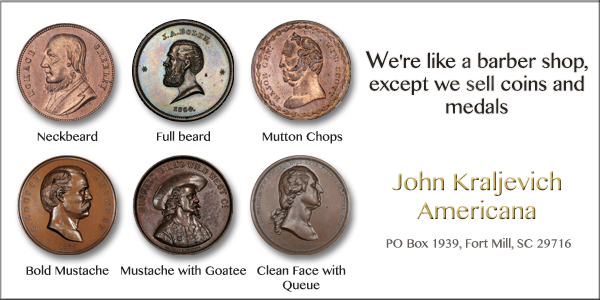
NEW BOOK: BRITISH HISTORICAL MEDALS OF THE 17TH CENTURY
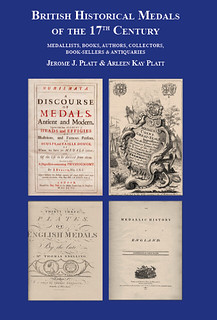 British Historical Medals of the 17th Century
British Historical Medals of the 17th Century
Medallists, Books, Authors, Collectors, Booksellers & Antiquaries
by Jerome J. Platt & Arleen Kay Platt
British Historical Medals of the 17th Century is another important book from the authors of The English Civil Wars: Medals, Historical Commentary & Personalities, completing their journey through the world of 17th century British medals and the medallists, authors, collectors, medal dealers and booksellers associated with them up to the present day. In this perfect companion to their comprehensive two volume work, the Platts have focused on British medals and medallists of the period from 1600 to 1688, telling the stories of the medallists and the books, booksellers, printers, print-sellers, and antiquaries associated with 17th century medals, as well as of the major sales, collectors and authors of works on the subject.
This is the perfect reference book for the collector to have to hand, based on over 40 years of research on 17th century medallists, 17th to 19th century books on these medals and their authors, as well as on eminent collectors and the collections which have come to auction to the present day; antiquaries associated with works on medal collecting, illustrators of antiquarian works and early publishers of books on the subject are also included. The nearly 300 illustrations of authors, collectors, books and booksellers, medals and old auction catalogues complement the text in providing a closer look at such luminaries as Vertue, Evelyn, Snelling, Pinkerton, Henfrey, Hawkins, Franks, Grueber, Hilliard, Briot, the de Passes, the Warins, Blondeau, Rawlins, Thomas and Abraham Simon, the Roettiers, Dassier, Kirk, Hunter, Sara Sophia Banks, Trattle, Perry, Thane, Caulfield, James, ‘Athenian’ Stuart, and even the late 18th century forger known as ‘Stuart,’ to name just some of the more than 80 individuals covered in this volume. This fascinating book will be of value to anyone who wishes to learn about the history of medal collecting and the association between coin- and medal-collecting, and is a must for all collectors and students of British historical medals.
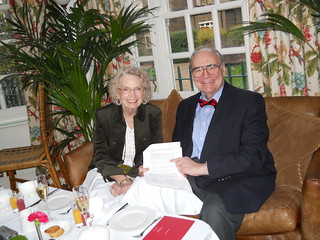 The authors after a meeting at Spink, at which they discussed publication of their previous two volumes on the medals of the English Civil Wars.
The authors after a meeting at Spink, at which they discussed publication of their previous two volumes on the medals of the English Civil Wars.
Jerome J. Platt is a retired medical school professor of psychiatry, research director and research dean who has been an active collector and researcher of British medals for over 40 years. Originally trained as a psychologist, Dr Platt became interested in the personalities of those personages depicted on medals of the English Civil War. This volume is the result of his study of the men and women who are associated with the history of historical and commemorative medal design, manufacture, sale, collecting and scholarship. Dr Platt is also the author or editor of over a dozen books on drug addiction, research and psychological issues.
Arleen Kay Platt is a retired registered nurse, hospital supervisor and research site manager who reports that she was initially drawn into the fascinating world of British medals while looking over her husband’s shoulder as he worked on his medal collection. She is a co-author of The Whitewash Brigade: The Hong Kong Plague of 1894 and The English Civil Wars: Medals, Historical Commentary & Personalities.
As attractive as historical or commemorative medals are in their own right and as telling as they are by their designs and inscriptions of the persons or events they honour (or, in some cases, vilify or deride), they tell us much more: by means of inscriptions, design and allegory, they tell us their age, of their makers, of the purpose for which they were made, the manner in which they were made, and the ‘story’ their maker wished to communicate.
This volume presents the published works on 17th century British medals that appeared in the late 17th century through to the 19th century as well as biographies of the authors. It also surveys those medallists who created the medals, the major collectors of the medals, the great collections that we know of through auction catalogues, the antiquaries and chroniclers who wrote on the period, or who were otherwise associated with these works, as well as early printers of numismatic works. It is intended as a companion volume to the authors’ two volume work, The English Civil Wars: Medals, Historical Commentary & Personalities.
Handsomely illustrated throughout with some 300 illustrations, this work is an essential addition to the libraries of collectors and students of both British and Continental Historical and Commemorative Medals.
Praise for The English Civil Wars: Medals, Historical Commentary & Personalities
“[This] book is a work of very great scholarship and dedication, having taken more than four decades from concept to fruition; but it is much more than this, it is the fruit of a burning, shared
passion which is reflected in the depth of detail, the delight in quotations, the personal observations and the rich, extensive illustrations...”
—Paul Christensen, Ph.D., Spink Numismatic Circular
For more information, or to order, see:
https://www.spink.com/departments.aspx?id=1210
NEW BOOK: STRIKING GOLD IN ALASKA, 6TH EDITION
 STRIKING GOLD IN ALASKA 6TH EDITION
STRIKING GOLD IN ALASKA 6TH EDITION
Alaska Rare Coins is pleased to announce the publication of the 6th edition of "Striking Gold in Alaska, Making tokens from placer gold" by Dick Hanscom.
The cover is the same, but it is enlarged and expanded. The 6th edition is 9 inches by 6 inches (enlarged) and 221 pages (expanded).
In the two years since the 5th edition, there are 17 new sources of gold (27 vs 44). Most have information from USGS reports about the location.
Several improved minting techniques are noted. New "on site" mintings are included. Private commissions are exposed for the first time.
The new chapter in this edition is on the Bechtler gold coins of North Carolina, the site of America's first gold rush. Through the courtesy of Dr. Donald H. Kagin, we have a short history of these fascinating coins.
The book is available for $22, shipped via priority mail. Orders can be sent to Alaska Rare Coins, P.O. Box 72832, Fairbanks, AK 99707.
Dick Hanscom adds:
What, you don’t have editions 1 to 5? A very limited number of sets from edition 1 to edition 5 are available for $32 postpaid. Editions 4 and 5 have articles that are not found in the other editions.
To read the earlier E-Sylum article, see:
NEW BOOK: STRIKING GOLD IN ALASKA, 5TH EDITION (http://www.coinbooks.org/esylum_v17n27a04.html)

NEW BOOK: A NUMISMATIC HISTORY OF CONGO/ZAïRE
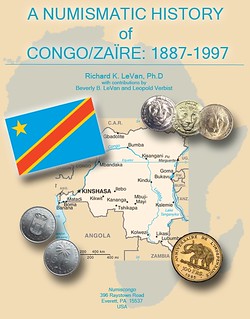 A Numismatic History of Congo/Zaïre: 1887-1997
A Numismatic History of Congo/Zaïre: 1887-1997
Richard K. LeVan
with contributions by
Beverly B. LeVan and Leopold Verbist
Exploring 110 years of Circulation and Proof coinage, 24 chapters, 359 pages with illustrations
ISBN: 978-0-692-81068-2
THIS book addresses the coinage of Congo/Zaïre. It sets the coins in their historical context as it moves in chronological fashion from the first silver and copper coins authorized by the Belgian King, Leopold II in 1887, for the Congo Free State (L'État indépendant du Congo) through the last silver and gold proof coins authorized by Joseph Mobutu in his final turbulent years as the President of Zaïre (1996-1997).
THIS chronicle, the first in English to provide a systematic discussion of this area of numismatic interest, will prove a valuable resource for collectors, coin dealers and auction houses, as well as those with an interest in African studies and history in general. It contains hundreds of pictures as well as specifications (size, weight, mintage figures, etc) for about every coin ever minted for Congo/Zaïre. Many essai/pattern coins as well as coins with notable strike anomalies, such as date over-strikes are also included.
THE majority of the coins in this volume are displayed larger than actual size for illustrative purposes - with the actual dimensions noted. The myriad of pictures were not extensively edited. They were collected from an array of sources, and therefore, vary in terms of quality, as do the coins they display.
AN attempt was made to be as thorough as possible. Therefore, even when a picture was not available of a known, extant coin example, other pertinent information about the coin is included when possible.
IDENTIFYING reference numbers for the coins are drawn primarily from the cataloging work of: Charles Dupriez (1949) and Léon Bogaert (1972), as well as Louis Ciani and Krause Mishler Publications. I have added a number of attributions for coins not previously listed, or clearly delineated. Where I have added attributions they are "built" primarily on the numbering system of Dupriez.
IT has been said that a coin is just a small piece of metal, seemingly inconsequential in the greater scheme of things - until it is examined in light of its historical context. Thereafter, everything changes, as it is revealed that the small piece of metal is actually a reflection of the political and socio-economic realities of its time and place. Whether that time period and culture be peaceful or tumultuous, much can be deduced contextually from the coinage of any particular age.
IN the period from 1887-1997, the Congo went through a metamorphosis. Initially the nation was ruled for some 23 years (commencing in 1885) by a foreign King, who imprinted his image on the first coin designs for the Congo Free State. As absolute ruler of the Congo Free State, Belgian King Leopold II's image was front and center on all the silver coinage of the period (1887-1896). Subsequently, renamed the Belgian Congo, and henceforth administered by the Belgian government, the coin designs for the colony would for decades, continue to portray Belgian heads-of-state, Albert II and then Leopold III, as the centerpiece.
THE Congo's coinage by the 1940's, finally began to reflect fauna of the country - elephants, with no reference to Belgian heads-of-state. In 1965 the newly independent Congo's first circulation coinage was released, featuring a lion design. Katanga's earlier experiment with independence (1961) produced the 1 and 5 franc pieces that included bananas and copper crosses in their design - with no portrait of a government official.
PORTRAITS of heads-of-state, so common in European coin designs, by 1965 were once again utilized on coins in the Congo. This time, however, it was Congo's first President, Joseph Kasa-Vubu that would grace a gold 5-piece Independence Anniversary Set. Subsequently, after Mobutu came to power, his portrait would anchor the obverse of Congo's coinage from 1967-1988, reflecting his central role in, and absolute control over the Congo's affairs. As it would turn out, this one-hundred-ten year period (1887-1997) would end as it had began, with supreme rulers, first Leopold II and then Mobutu, stepping (or forced as the case may be) aside as cries for economic and societal reforms rang aloud both in and outside the Congo. Thus the Congo's coinage is a lasting and tangible testament to the historic and economic realities, of both the Congo itself and the nations with which it interacted . . .
FORTUNATELY, for those who collect and study African coinage, this hundred-ten year period of the Congo's development offers a wealth of opportunity. Almost all the coin types ever minted for the Congo Free State, Belgian Congo, Katanga, Democratic Republic of Congo and Zaïre can be found in the numismatic marketplace. These coins while readily available in circulated condition, can in many instances, be found in uncirculated grades as well, even those dating back to the first years of the Congo Free State. In addition, in recent years a number of essai/pattern strikes have appeared in International auctions, some dating from 1887, the Congo's first year of coinage. Hopefully, armed with an understanding of the cultural context and significance of these pieces, all of our collecting experiences will be enhanced, and consequently made more productive, enjoyable and fulfilling.
For more information, or to order, see:
http://www.numiscongo.com/
NEW BOOK: DECCAN SULTANATE COINS
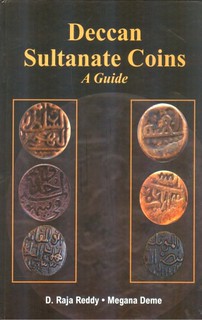 Islamic coins were first issued in India by the Amirs of Sind in the eight century AD and their regular coinage commenced in the eleventh and twelfth century AD by the Sultans of Delhi.
Bahmani was the first major Muslim dynasty (748-942AH/ 1347-1538AD) to rule in the Deccan after their revolt against the Tughlaq rule five succession states emerged in the Deccan and they are Barid
Shahi (895-1028AH/ 1489-1619AD), Nizam Shahi (902-1046AH/ 1496-1636AD), Adil Shahi (895-1097AH/ 1490-1686AD), Qutb Shahi (895-1098AH/ 1489-1687AD) and Imad Shahi (895-980AH/ 1484-1572AD)
respectively.
Islamic coins were first issued in India by the Amirs of Sind in the eight century AD and their regular coinage commenced in the eleventh and twelfth century AD by the Sultans of Delhi.
Bahmani was the first major Muslim dynasty (748-942AH/ 1347-1538AD) to rule in the Deccan after their revolt against the Tughlaq rule five succession states emerged in the Deccan and they are Barid
Shahi (895-1028AH/ 1489-1619AD), Nizam Shahi (902-1046AH/ 1496-1636AD), Adil Shahi (895-1097AH/ 1490-1686AD), Qutb Shahi (895-1098AH/ 1489-1687AD) and Imad Shahi (895-980AH/ 1484-1572AD)
respectively.
Islamic coins are unique not only for their calligraphy but also for the wealth of information that they provide and Bahmani and the five succession dynasties coins are no excepton. Islamic coins usually have mints name, year of issue in Hijri era, regnal year and a legend which could be very elaborate and truly reveal the charcter of the issuer. Another charavterisic of Islamic coins is the mention of the name of the father of the issuer which makes it easy to identify the king especially when his name is comon like Ahmad and Muhammad. For example there wear four. Ahmads and three Muhammad's out of eighteen Bahmani rulers and each king can be identified because they mention the name of their father and sometime even their grandfather.
Deccan Sultanate coins are available in plenty in the market and this books is a guide for those non-Urdu knowledgeable coin enthusiasts to identify them and find new coins.
Authors (s): D. Raja Reddy (Author) , Megana Deme (Author)
Format: Hardcover
ISBN-10: 9386223252
ISBN-13: 9789386223258
Pages: viii+60p., Ills; Partly Col; Maps; 23cm.
Pub. date: 03.07.2017, 1st.ed.
Publisher: B. R. Publishing Corporation
Language (s): English
Bagchee ID: BB108754
List price: US $ 60,00
Bagchee price: US $ 54,00
To read the complete article, see:
Overview for Deccan Sultanate Coins: A Guide
(http://www.bagchee.com/books/BB108754/deccan-sultanate-coins-a-guide)

NEWMAN PAPERS REVEAL 1792 U.S. MINT DOCUMENT
Numismatic tidbits are endless in the Newman papers, and, while processing the “S” files, we ran across an interesting exchange between Eric P. Newman and Sotheby’s in London. In a 1970 sale of autograph letters and historical documents, Sotheby’s described lot 548 of their May sale as follows:
WASHINGTON, GEORGE to THOMAS JEFFERSON: written as President, ABOUT THE ESTABLISHMENT OF THE UNITED STATES MINT, recommending that the site for it (“the Lots of Houses which are offered for sale”) should be purchased rather than rented, etc., integral second leaf addressed “Mr. Jefferson” in Washington’s hand …
Newman wrote to Sotheby’s on June 12, 1970 requesting a photocopy of the Washington letter. Sotheby’s demurred on June 16, explaining “I am afraid I cannot send you a photo-copy of the letter as this is an unpublished document and it is a rule of the firm in this case not to give out photocopies to protect the potential buyer. The estimate on this lot is £600-800.”
Today, of course, one simply visits the Founders Online site, and the full text of the letter is immediately revealed. This site has gathered together the edited papers and correspondence of Washington, Jefferson, and others instrumental in the birth of the United States. This particular Washington letter currently resides in the Gilder Lehrman collection at the New-York Historical Society (N-YHS), so it seems likely the letter was purchased out of the Sotheby’s sale and later donated to the N-YHS. The full text reads:
To Thomas Jefferson [Philadelphia] Saturday June 9th [17]92
Dear Sir,
I am in sentiment with you & the Director of the Mint, respecting the purchase of the Lots & Houses which are offered for Sale in preference to Renting—as the latter will certainly exceed the Interest of the former.
That all the applications may be brought to view, & considered, for Coining &ca; Mr Lear will lay the letters and engravings before you to be Shewn to the Director of the Mint. I have no other
object or wish in doing it than to obtain the best. Yrs &ca
Go: Washington
Link to Newman/Sotheby’s correspondence on Newman Portal:
https://nnp.wustl.edu/library/book/534009
Link to Washington letter on Founders Online:
https://founders.archives.gov/documents/Washington/05-10-02-0293
HARLEY FREEMAN COLONIAL PAPER MONEY INVENTORY
Colonial Paper Money Collectors
Inventory Includes Provenances Back to Chapman
(Stuart Hanebuth)
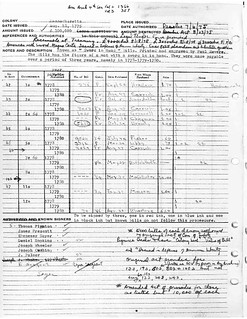 In December 2015 the Newman Portal unceremoniously posted a document entitled, Colonial & Continental Currency Inventory and Data Sheets: Supplemented with Additions and Corrections of
Eric P. Newman. The 560-page document may be one of the most important documents in colonial currency. The file contains a comprehensive inventory of colonial and Continental paper money that was
compiled in the middle of the last century by Harley Freeman; and contains details about the rarest pieces in the hobby along with hand written notes covering the legislation authorizing the bills
and their signers. Freeman intended to write a book on colonial currency using this research but never did. Undoubtedly Newman used much of the research in The Freeman Journal to create the first
edition of The Early Paper Money of America.
In December 2015 the Newman Portal unceremoniously posted a document entitled, Colonial & Continental Currency Inventory and Data Sheets: Supplemented with Additions and Corrections of
Eric P. Newman. The 560-page document may be one of the most important documents in colonial currency. The file contains a comprehensive inventory of colonial and Continental paper money that was
compiled in the middle of the last century by Harley Freeman; and contains details about the rarest pieces in the hobby along with hand written notes covering the legislation authorizing the bills
and their signers. Freeman intended to write a book on colonial currency using this research but never did. Undoubtedly Newman used much of the research in The Freeman Journal to create the first
edition of The Early Paper Money of America.
Figure 1 - A Page from the Harley L. Freeman Inventory of Colonial and Continental Currency
Harley Freeman was a collector who lived from 1895 to 1976. Mr. Freeman lived in Cleveland, Ohio until 1947 when he retired to Florida. Freeman began collecting coins as a child and was active in the ANA where he was chairman of the board in 1933 and was a charter member of the Western Reserve Numismatic Society. Mr. Freeman was also founder and president of the Daytona Beach Numismatic Club. He assembled a collection of Colonial and Continental paper money in a class with legendary collections like Henry Chapman, Joshua Cohen, F.C.C. Boyd and John Ford. The Freeman collection was acquired Eric Newman in the 1960’s.
The inventory in the Freeman Journal tracks many colonial and Continental bills in the Freeman Collection back to the great collections of Henry Chapman, Joshua Cohen, T. James Clarke, Wayte Raymond and many others. It also contains a comprehensive listing, by emission and denomination, of bills that are housed in over a dozen museum collections. Some of Freeman’s purchase prices are coded using the letters: A,C,H,J,N,O, R, S, T,U and Y.
Analysis of the inventory suggests that the code, in part, was as follows:
R – 1; S – 2; T – 3; U – 4; Y – 5, ? – 6; A – 7; 8 – ?; 9 – ?
C, H, J and O are Unassigned/Unknown
Given the data, it is difficult to speculate as to the assignment of C,H,J and O. While somewhat trivial, understanding the cost basis for Freeman’s acquisitions provides insights into the history of collecting colonial bills.
Newman acquired the Freeman Collection and many of the bills which have appeared in the recent Newman Auctions are listed in Freeman’s inventory. Bills in Freeman’s collection contain information on the purchase price, date acquired and the source of the acquisition.
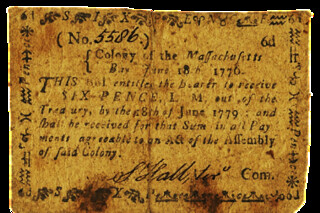 One of the bills that was recently sold as a part of the Newman auctions was a 6 Pence Massachusetts bill from the June 18, 1776 Bill. The bill, serial number 5586, had a due date of June
1779. The exact bill appears in Freeman’s inventory, which shows that he purchased the bill from Henry Chapman in July of 1936 for $0.75, a fraction of its most recent $200 sale price. This is just
one of many examples of provenance data in the inventory.
One of the bills that was recently sold as a part of the Newman auctions was a 6 Pence Massachusetts bill from the June 18, 1776 Bill. The bill, serial number 5586, had a due date of June
1779. The exact bill appears in Freeman’s inventory, which shows that he purchased the bill from Henry Chapman in July of 1936 for $0.75, a fraction of its most recent $200 sale price. This is just
one of many examples of provenance data in the inventory.
Figure 2 – (Right) A Six Pence bill form the Massachusetts June 18 , 1776 emission. This bill, recently sold in the Newman Auctions, was purchased from Chapman by Freeman for $0.75. (Below) A Page from the Harley L. Freeman Inventory recording its seller and purchase price.

PCGS Currency has confirmed that they will recognize the provenances in the Freeman Journal when grading colonial bills, allowing this bill to appear in a holder that includes the Chapman provenance.
The Freeman Inventory is one of the most important works in colonial paper money. It provides valuable population data, as well as insights into the history of the vast Newman collection currently at auction. Understanding how the pieces in our collections have traveled through time is as important as understanding their contemporaneous importance. Thanks to the work of the Newman Foundation collectors can appreciate that history now, and for time to come.
For more information on the Colonial Coin Collectors Club, see:
http://colonialcoins.org/
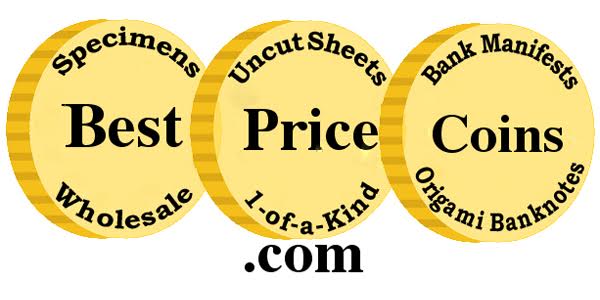
A LIST OF COIN PERIODICAL WEB SITES
I recognize that there is a grey area between a periodical and a blog, especially when a periodical is purely online. The E-Sylum for example, has elements of both, but it's primarily an online periodical. I'm also wrestling with how to classify publisher web sites which contain multiple periodicals, like NumisMaster or Token Publishing. I haven't listed most club e-newsletters here either (since many are email-only and not available on the web), but maybe I should. Comments welcome. Organization is evolving, but please help us make sure the the best periodicals are included somehow. -Editor
- Canadian Coin News
- Indian Coin News
- CDN Publishing
- Mint Error News
- Journal of the Research Association on Monetary Innovation and Complementary and Community Currencies (RAMICS)
- Token Publishing
- Coins and Canada
- The Canadian Numismatic Publishing Institute
- CoinsWeekly
- Coin News
- Coin Update
- Coin World
- CoinWeek
- NumisMaster
- Numismatic News
- The E-Sylum
To visit the Newman Numismatic Portal, see:
https://nnp.wustl.edu/
Thanks to Brandon Grossardt, who writes:
I read your recent post about Coin Forum sites. Your list is quite comprehensive for English language sites, but I offer below just a few comments:
- The "Collectors Universe Message Boards" and "PCGS Message Boards" are the same thing. No need to list them twice.
- A very good site in English and for collectors of British material is the "British Coin Forum -- Predecimal.com" at this link: http://www.predecimal.com/forum/
- The "Coin Community" boards are called "Coin Community Family" or "CCF" forum by many.
To read the earlier E-Sylum articles, see:
A LIST OF COIN BLOG WEB SITES (http://www.coinbooks.org/v20/esylum_v20n30a28.html)
A LIST OF COIN FORUM WEB SITES (http://www.coinbooks.org/v20/esylum_v20n31a14.html)
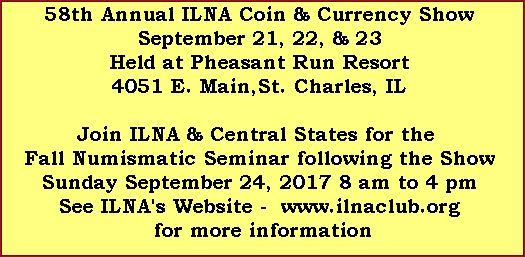
NOVA CONSTELLATIO QUINT STRUCK AS AMERICAN COIN
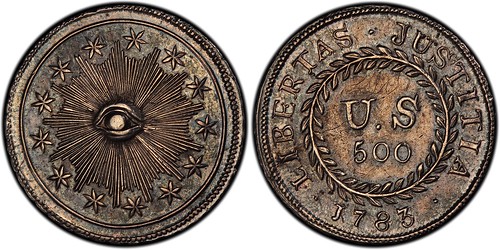
David McCarthy, senior numismatist at Kagin’s, Inc. of Tiburon, California (www.Kagins.com), has pinpointed the 1783 plain obverse Nova Constellatio Quint pattern (Breen-1102, W-1830) as the first coin officially struck by authority of the United States government, a finding hailed by another U.S. rare coin expert as “one of the most exciting developments in modern numismatics.”
Results of McCarthy’s research on the unique, early American experimental silver coin, that once was in the hands of one of the USA’s Founding Fathers, Alexander Hamilton, are in the August 2017 edition of “The Numismatist,” the official journal of the American Numismatic Association (www.money.org).
“Although the coin was discovered in 1870, it was misattributed. We now have compelling evidence that it is, ‘the first that has been struck as an American coin,’ as described in the April 2, 1783 diary entry of Robert Morris, a signer of the Declaration of Independence and the U.S. government’s first Superintendent of Finance,” explained McCarthy.
“The Quint and a subsequent set of coins were created in Philadelphia in April of 1783 under authority of the Treasury some nine years before the next coins would be struck by the U.S. government. It would have been valued at 500-units in a proposed system that would range from 5 to 1,000 units,” McCarthy said.
“This was the first use of the vital and enduring decimal system to be established in the western world,” stated Kagin.
During the 1770s and 1780s several states and private individuals manufactured coins, but this is the first coin that was struck and paid for by the U.S. government, according to McCarthy’s research, which a dozen other early American coin experts agreed with before he submitted it for publication.
After examining McCarthy’s research, early American coins researcher and writer John Dannreuther of Memphis, Tennessee, the American Numismatic Association’s 2007 Numismatist of the Year, summed up the findings:
“There is a first United States coin, as we have written evidence (in the April 2, 1783 diary entry of Robert Morris, U.S. Superintendent of Finance) that one was delivered: ‘I sent for (metallurgist) Mr. (Benjamin) Dudley who delivered me a Piece of Silver Coin being the first that has been struck as an American Coin.’
“The only coin that logically could be this coin is the Plain Obverse Quint. “There are numerous things that bring us to this conclusion, the first being that “Nova Constellatio” is not found on the Plain Legend Quint. One does not remove legends, they are added,” explained Dannreuther.
“Secondly, the number of dies noted in the literature can be made to match only by having one die ground down and reengraved. After overlaying the two Quint types, it became obvious that the Plain Obverse die’s eye matched the with Legend eye. Since this is the highest point of the coin, it is the lowest part of the die, as well as the center, it would be logical to leave a small amount of this area as a starting point for the new die. The rest of the die’s detail was removed by the grinding process, of course.”
“Thirdly, the two Quint dies obviously were engraved by two different hands. Since, we know that the with Legend coins match the other denominations in style, as well as having the “Nova Constellatio” legend, the Plain Obverse has to be the first one – thus, it is the first United States coin,” stated Dannreuther.
Only two examples of the 500-unit coin are known, and each is distinctively different on the front. One has the words, NOVA CONSTELLATIO, Latin for “a new constellation,” while the other example does not have any words. The research demonstrates the coin without the words on the obverse was struck first.
After surfacing in New York City nearly 150 years ago, the coin was carefully preserved in several major collections including Lorin G. Parmelee, S.H. and H. Chapman and Wayte Raymond before becoming part of the Garrett Collection and into the possession of Johns Hopkins University where it resided for much of the 20th century. Only now, though, has numismatic research brought together evidence that it was the first federal coin made by authority of the U.S. government.

QUERY: MYSTERY JAPANESE ITEMS
Dick Hanscom of Fairbanks, Alaska writes:
I wonder if readers can help on these, images attached. One gold, one silver.
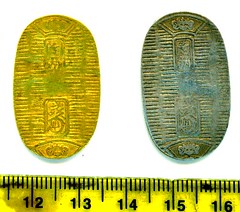
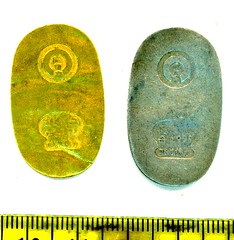
So, dear readers - what do your humans brains think thee are? -Editor

MORE ON THE MYSTERY "SILK TRADE TOKEN"
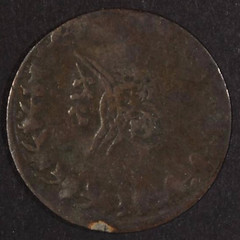

Regarding the "Silk Trade Token" item shown on last week's Numismatic Nuggets" article, Chip Howell writes:
It looks Ottoman to me--I think it says "struck in Constantinople" & the date looks like AH 1255 = ~1839.
Ken Spindler of San Diego writes:
The "1500 AD SILK TRADE TOKEN" is either a Turkey 10 para (KM-652) or 20 para (KM-653) of Abdul Mejid dated AH 1255, year 1 (=1839), Constantinople mint, which was struck in billon, a very low fineness silver alloy. It is depicted rotated almost 90 degrees counterclockwise, obviously by someone who has no clue. In the center of the first photo is the sultan's toughra - calligraphic monogram - almost sideways. (The added floral branch should be positioned from about 1:00 to 3:00.) It's a common little coin, in lousy condition. Dealer's junk box material.
Nothing personal, of course.
Ron Haller-Williams of Surbiton, Surrey, England writes:
Was this included to see if we were awake? Or was it intended for April 1st? Turkey itself wasn't really on the silk road. And what's this about "1500 AD"?
This piece seems to be a billon 20 PARA coin dated AH 1255 (1839 AD), for use in the Ottoman (Turkish) Empire (KM #653). It was issued in the first year of the reign of Abdülmecid I, who came to the throne in AD 1839 = AH 1255 or ١٢٥٥ and died in AD 1861 = AH 1277 or ١٢٧٧.
I have taken the supplied pictures, rotated them, adjusted brightness and contrast, and annotated the result. Now compare with what can be seen at e.g. https://www.ngccoin.com/price-guide/world/turkey-20-para-km-653-1255-1-1255-5-cuid-1114494-duid-1551842
The appearance of the word مصر (Egypt) has me fooled at first – I thought the coin was for use in Egypt! But, of course, "Ruler of Egypt" was one of the Sultan's titles.
The piece has clearly been mounted or connected to a ring for suspension or attachment, see the scar at about 11 o'clock on the obverse or 1 o'clock on the reverse. So it could perhaps be a copy as used in the clothing and scarves/shawls of dancers, somewhat like at http://www.worldbellydance.com/wp-content/uploads/2016/04/Gold-coin-291x300.jpg .

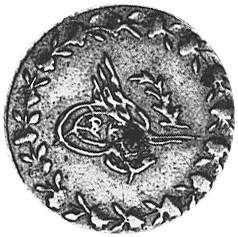
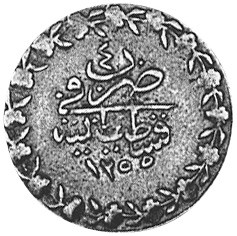
Regarding the mention of Egypt, Chip Howell writes:
I have to dispute this--that's not Misr (Egypt) but Duriba (struck) because that's what I'm reading as "struck in Qonstantiniyah" (i.e., Istanbul). The first letter is too big to be a "meem".
To read the earlier E-Sylum article, see:
NUMISMATIC NUGGETS: JULY 30, 2017 (http://www.coinbooks.org/v20/esylum_v20n31a29.html)
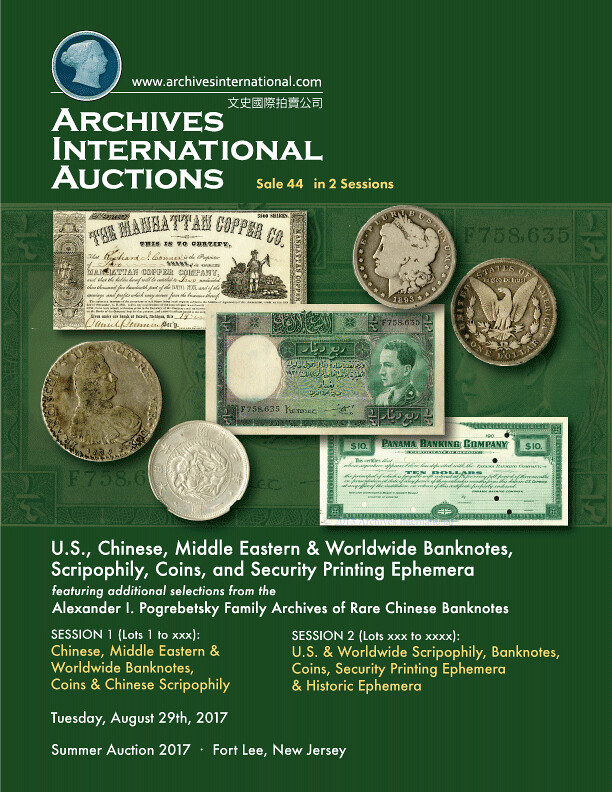
NOTES FROM E-SYLUM READERS: AUGUST 6, 2017
Neither Neither Bison Nor Buffalo

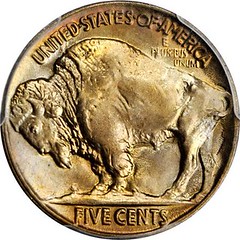
Eric Hodge writes:
Thank you, once again, for an excellent issue. You do know how to tell the difference between a Buffalo and a Bison? You cannot wash your hands in a Buffalo.
Ralph Winter writes:
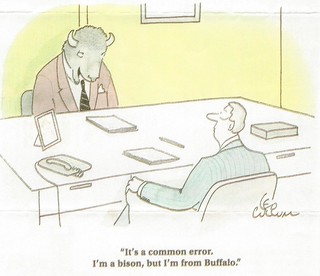 I liked the Reader's Digest cartoon submitted by Dick Johnson. But in answer to his inquiry, it's neither Bison nor Buffalo but Indian Head Nickel.
I liked the Reader's Digest cartoon submitted by Dick Johnson. But in answer to his inquiry, it's neither Bison nor Buffalo but Indian Head Nickel.
To read the earlier E-Sylum articles, see:
COIN WORLD STYLE GUIDE (http://www.coinbooks.org/esylum_v05n31a05.html)
NOTES FROM E-SYLUM READERS: JULY 30, 2017 : Bison or Buffalo? (http://www.coinbooks.org/v20/esylum_v20n31a20.html)
More on Taiwan’s Tokens
James Contursi writes:
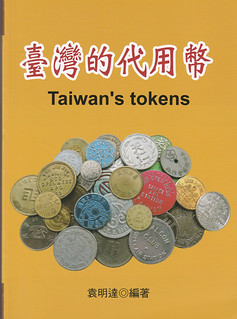 Thank you very much for that copy of The E-Sylum newsletter. I read it and, frankly, I am astounded that you can put something of that quality and breadth out on a weekly basis. Sir,
I tip my hat to you.
Thank you very much for that copy of The E-Sylum newsletter. I read it and, frankly, I am astounded that you can put something of that quality and breadth out on a weekly basis. Sir,
I tip my hat to you.
Also, thank you for bringing Yuan Mingda’s book, Taiwan’s Tokens, to the attention of so many numismatic bibliophiles.
To read the earlier E-Sylum article, see:
NEW BOOK: TAIWAN'S TOKENS (http://www.coinbooks.org/v20/esylum_v20n31a07.html)
More on Wikipedia As an Information Source
Paul Schultz writes:
Thought I would weigh in on the use of Wikipedia as a reference. As a chemist who is sometimes asked to get quick information on an obscure branch of the field that is outside my normal expertise, I have found wikipedia to be remarkably reliable. Sometimes people who specialize in obscure subjects like to write up excellent detailed articles on thier specialty and put it in Wikipedia, and it is often information that woud be very time consuming to track down elsewhere.
I think some judgement is needed in determining the validity of Wikipedia articles. I would not trust popular and trendy topics without checking other sources. I would have an eye out for statements that don't make sense in the context of what I already know. But if the topic is not a likely subject for those of questionable interests, and the contents indicate the author must have a good academic knowledge of the topic, I have found a substantial number of articles that are valuable and reliable. There are a lot of nerds out there who jump all over a small mistake in an article on their favorite topic (yes, your honor, I'm guilty as charged).
To read the earlier E-Sylum article, see:
NOTES FROM E-SYLUM READERS: JULY 30, 2017 : Wikipedia As an Information Source
(http://www.coinbooks.org/v20/esylum_v20n31a20.html)
THE BOOK BAZARRE
THE LONG AND THE SHORT OF THE CCAC
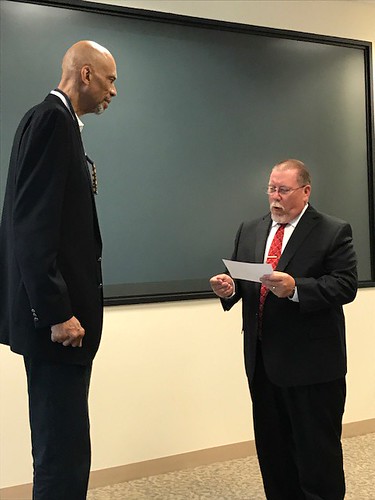
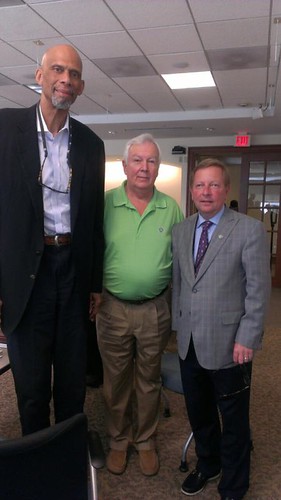
Citizens Coinage Advisory Committee meeting June, 2017
The United States Mint is pleased to announce the appointment of Kareem Abdul-Jabbar to the Citizens Coinage Advisory Committee (CCAC). Mr. Abdul-Jabbar fills the vacancy created this year by the resignation of Steven Roach, a member representing the interests of the general public. Mr. Abdul-Jabbar, a renowned former professional basketball player who is an avid coin collector, became interested in numismatics based on his love of history and his study of Alexander Hamilton. Currently, he serves as the chairman of his Skyhook Foundation, whose mission is to “Give Kids a Shot That Can’t be Blocked” by bringing educational opportunities to under-served communities through innovative outdoor environmental learning. He is also a regular contributing columnist to The Washington Post and Time Magazine, and a best-selling author of literary fiction and non- fiction books. On November 23, 2016, he was awarded the Presidential Medal of Freedom from President Barack Obama in recognition of his outspoken advocacy of social justice.
Our association president and CCAC member Tom Uram was in Washington D.C. this past June for a CCAC meeting. The top left photo is Kareem Abdul-Jabbar the Citizens Coinage Advisory Committee’s
newest member being sworn in by Acting Deputy Director of the United States Mint David Motl. The photo at right shows Kareem with PAN Clarion Editor Richard Jewell (playing center) and PAN President
Tom Uram (playing small forward). Coin collectors come in all shapes and sizes. PAN is delighted to welcome Kareem to the coin collecting team!
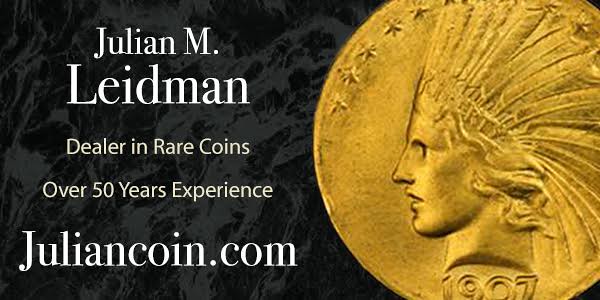
2018 AMERICA THE BEAUTIFUL QUARTER DESIGNS
 The United States Mint (Mint) unveiled reverse (tails side) designs for the 2018 coins in its multi-year America the Beautiful Quarters® Program today at the American Numismatics
Association's World's Fair of Money.
The United States Mint (Mint) unveiled reverse (tails side) designs for the 2018 coins in its multi-year America the Beautiful Quarters® Program today at the American Numismatics
Association's World's Fair of Money.
The national sites to be recognized in 2018 are Pictured Rocks National Lakeshore in Michigan, Apostle Islands National Lakeshore in Wisconsin, Voyageurs National Park in Minnesota, Cumberland Island National Seashore in Georgia and Block Island National Wildlife Refuge in Rhode Island.
The design representing Pictured Rocks National Lakeshore depicts Chapel Rock and the white pine tree that grows atop with the inscriptions "PICTURED ROCKS," "MICHIGAN," "2018" and "E PLURIBUS UNUM." This reverse was designed by Artistic Infusion Program (AIP) Designer Paul C. Balan and sculpted by Mint Sculptor-Engraver Michael Gaudioso.
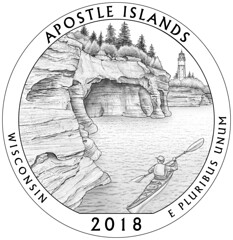

The design representing Apostle Islands National Lakeshore depicts the sea caves at Devils Island with the lighthouse in the background and a kayaker paddling in the foreground. Inscriptions are "APOSTLE ISLANDS," "WISCONSIN," "2018" and "E PLURIBUS UNUM." This reverse was designed by AIP Designer Richard Masters and sculpted by Mint Sculptor-Engraver Renata Gordon.
The design representing Voyageurs National Park depicts a common loon with a rock cliff in the background and the inscriptions "VOYAGEURS," "MINNESOTA," "2018" and "E PLURIBUS UNUM." This reverse was designed by AIP Designer Patricia Lucas-Morris and sculpted by Mint Sculptor-Engraver Joseph Menna.

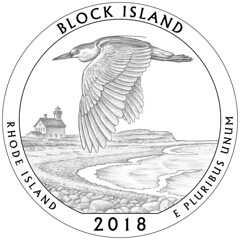
The design representing Cumberland Island National Seashore depicts a snowy egret perched on a branch on the edge of a salt marsh, ready for flight. Inscriptions are "CUMBERLAND ISLAND," "GEORGIA," "2018" and "E PLURIBUS UNUM." This reverse was designed by AIP Designer Donna Weaver and sculpted by Mint Sculptor-Engraver Don Everhart.
The design selected for the quarter honoring Block Island National Wildlife Refuge depicts a black-crowned night-heron flying over a view from the beach at Cow Cove looking towards Sandy Point. The North Lighthouse is seen in the background. Inscriptions are "BLOCK ISLAND," "RHODE ISLAND," "2018" and "E PLURIBUS UNUM." This reverse was designed by AIP Designer Chris Costello and sculpted by Mint Sculptor-Engraver Phebe Hemphill.
The obverse (heads) of the 2018 quarters will continue to feature the 1932 portrait of George Washington by sculptor John Flanagan. Required obverse inscriptions are "UNITED STATES OF AMERICA," "LIBERTY," "IN GOD WE TRUST," and "QUARTER DOLLAR."
2018 marks the ninth year of the America the Beautiful Quarters® Program authorized by Public Law 110-456, the America's Beautiful National Parks Quarter Dollar Coin Act of 2008 (Act). The Act directs the Mint to design, mint, and issue quarter-dollar coins emblematic of a national park or other national site in each state, the District of Columbia, and the five U.S. territories. In accordance with the Act, the Mint is issuing the new quarters at the rate of five per year until 2020 in the order in which each honored site was first established. The final coin will be released in 2021.
To read the complete article, see:
United States Mint Reveals Final America the
Beautiful Quarters® Program Coin Designs for 2018 (https://www.usmint.gov/news/press-releases/united-states-mint-reveals-final-america-the-beautiful-quarters-program-coin-designs-for-2018)
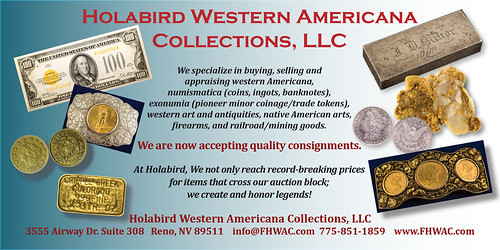
VOCABULARY TERM: FOUNDING DATE
Founding Date. A date appearing on a medal in which the organization issuing the medallic item was founded, incorporated or instituted. Infrequently a medal is
issued, or a medal program created, the same year as the founding date; therefore it can be assumed any medal of that organization was issued after that date. Other evidence – as an inscribed date or
date on the edge – should be considered as the date of issue. Founding dates are important for the issuing of anniversary medals. Formerly the source of founding dates were in published company
histories or in financial sources such as Dunn & Bradstreet . With the internet these are now easily found. See DATES AND DATING.
CLASS 02.10
Looking for the meaning of a numismatic word, or the description of a term? Try the Newman Numismatic Portal's Numismatic Dictionary at: https://nnp.wustl.edu/library/dictionary
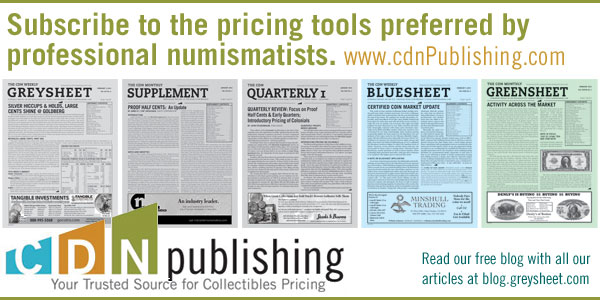
ARTHUR WHITE WESTHORPE (1869-1927)
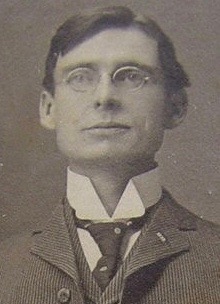 Arthur White Westhorpe (1869-1927), was born in February, 1869, in Gloucestershire, England, son of George Westhorpe (1826-), and Anne Maria Westhorpe (1829-). In 1878 at age nine he began
collecting English farthings. By 1879 he already amassed an extensive collection of over 100 English and foreign coins and medals. In 1880 he collected his first brass Roman coin that sparked his
interest into a specialty. He came to America in 1886. He worked in a dry goods store at Yankton, South Dakota. About 1898 he began to work for the Gazette at Yankton as city editor.
Arthur White Westhorpe (1869-1927), was born in February, 1869, in Gloucestershire, England, son of George Westhorpe (1826-), and Anne Maria Westhorpe (1829-). In 1878 at age nine he began
collecting English farthings. By 1879 he already amassed an extensive collection of over 100 English and foreign coins and medals. In 1880 he collected his first brass Roman coin that sparked his
interest into a specialty. He came to America in 1886. He worked in a dry goods store at Yankton, South Dakota. About 1898 he began to work for the Gazette at Yankton as city editor.
He was called the "Hobby Man of Yankton" since he was both a lepidopterist and numismatist, as well as a genealogist who often assisted Daughters of the American Revolution trace their ancestry.
He applied for membership in the A. N. A. and became friends with Dr. George Francis Heath (1850-1908). He became A.N.A. Member No. 127 when Dr. Heath reassigned the numbers. He collected ancient Roman and Middle Eastern coins. He reapplied in May 1909.
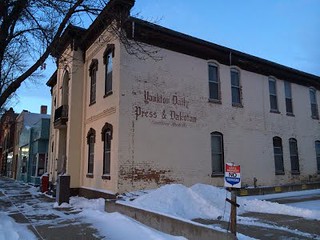 He worked as the city editor of a newspaper, The Press and Dakotan.
He worked as the city editor of a newspaper, The Press and Dakotan.
He was a member of the British Numismatic Society.
In 1894 he married Clara Louise Edwards (1873-1908). They had four children... His ancient coin collection was sold on February 18, 1910, by Ben G. Green, 51st sale.
He donated a collection of ancient Roman coins to Yankton College and it is now in their museum.
In December 1919 he complete the task of attributing the vast collection of ancient coins in the Conception Abbey Museum, Conception, Missouri. They were discovered in an ancient vase in an excavation at Jerusalem by a Benedictine monk and sent to the Abbey at Conception.
In 1921 he was hailed as the oldest member of the A.N.A.
He died in January 4, 1927 at Yankton, South Dakota. He is buried at Yankton Memorial Cemetery, Yankton, South Dakota.
To read the complete article, see:
WESTHORPE, ARTHUR WHITE
(https://sites.google.com/a/numismaticmall.com/www/numismaticmall-com/westhorpe-arthur-w)
REV. JUSTUS DOOLITTLE (1824-1880)
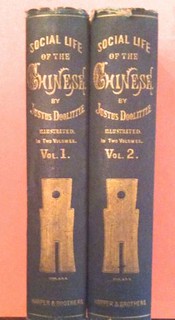 Rev. Justus Doolittle (1824-1880), American Board missionary in China, is well-known for his publications, including
Rev. Justus Doolittle (1824-1880), American Board missionary in China, is well-known for his publications, including
- Social Life of the Chinese, with some accounts of their religious, governmental, educational and business customs and opinions, with special but not exclusive reference to Fuhchau [Fuzhou] (1865)
- Social Life of the Chinese: a daguerrotype of daily life in China (1868)
- A Vocabulary and Hand-book of the Chinese Language (1872).
He was also a collector of Chinese coins. Note the spade-money issued by Wang Mang on the spines of these books!
Doolittle died on 15 June 1880. His collection of Chinese coins was sold a year later by Messrs Bangs & Co., 739 and 741 Broadway, New York City, in June 1881, and a printed catalogue was prepared: Catalogue of American and foreign coins and medals, the collection of O.A. Jenison, of Lansing, Mich. Also, the collection of Chinese coins formed by Rev. Justus Doolittle, of China. Together with a fine and large collection of Union envelopes, the property of a lady of Boston. And a collection of old coin sale catalogues. to be sold by auction, by Messrs. Bangs & Co. ... on Wednesday and Thursday, June 22, 23, 1881.
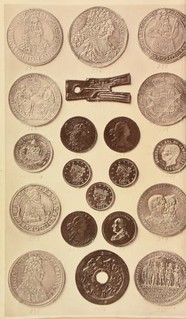
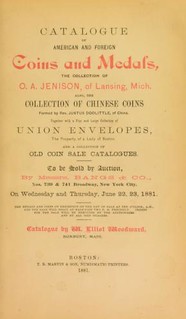
To read the complete article, see:
COLLECTOR: JUSTUS DOOLITTLE (1824-1880)
(https://chinesemoneymatters.wordpress.com/2017/08/01/collector-justus-doolittle-1824-1880/)
To read the complete catalog on the Newman Numismatic Portal, see:
CATALOGUE OF AMERICAN AND FOREIGN COINS AND MEDALS, THE COLLECTION OF O. A. JENISON, OF LANSING, MICH. ALSO, THE
COLLECTION OF CHINESE COINS FORMED BY REV. JUSTUS DOOLITTLE, OF CHINA. TOGETHER WITH A FINE AND LARGE COLLECTION OF UNION ENVELOPES, THE PROPERTY OF A LADY OF BOSTON. AND A COLLECTION OF OLD COIN
SALE CATALOGUES. (https://nnp.wustl.edu/library/auctionlots?aucCoId=29&auctionId=511216)
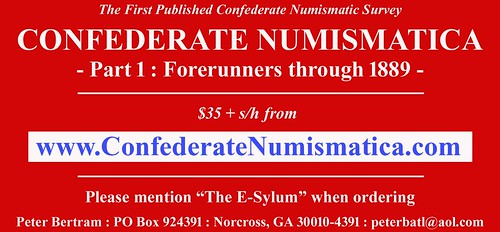
PCGS COINFACTS DEALER HALL OF FAME INDUCTEES
On Friday, August 4, 2017, two more renowned numismatists joined the ranks of the PCGS CoinFacts Coin Dealer Hall of Fame.
In the final days of this year’s World’s Fair of Money, during the PCGS Set Registry Luncheon, Kevin Lipton and the late David Proskey joined the esteemed list of numismatists that comprise the PCGS CoinFacts Hall of Fame.
"It’s important that we acknowledge those who have made tremendous contributions to the industry and the hobby we love. Kevin Lipton and David Proskey did just that. The PCGS CoinFacts Hall of Fame has been adding prestigious names from throughout numismatics since 2010, and we look forward to adding many more in the years to come," said PCGS CoinFacts President Ron Guth.
Kevin Lipton (1959-) Dealer career 1973 to date, HOF: 2017
 Kevin Lipton started buying and selling coins at age 13 and within a few years earned a reputation as one of the great numismatic prodigies. At only 17 years of age, he started his own
company, Kevin Lipton Rare Coins, and was one of the major players in the rare coin market, taking part in many of the largest deals of the era.
Kevin Lipton started buying and selling coins at age 13 and within a few years earned a reputation as one of the great numismatic prodigies. At only 17 years of age, he started his own
company, Kevin Lipton Rare Coins, and was one of the major players in the rare coin market, taking part in many of the largest deals of the era.
In 2000, Lipton was the recipient of the PNG’s "Sol Kaplan Award" for his help in cleansing the profession of fraud and thievery, and in 2012, he was awarded the "Life Time Achievement Award" by the PNG at the young age of 53.
David Proskey (1853-1928) Dealer career 1873-1928, HOF: 2017
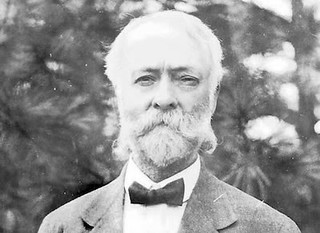 David Ulysses Proskey was one of the unsung heroes of numismatics from the late 1800s through the turn of the century and beyond. He was a coin dealer, stamp expert, mineralogist,
researcher, and active writer from 1873 until the time of his death in 1928.
David Ulysses Proskey was one of the unsung heroes of numismatics from the late 1800s through the turn of the century and beyond. He was a coin dealer, stamp expert, mineralogist,
researcher, and active writer from 1873 until the time of his death in 1928.
Born in 1853, the collecting bug hit Proskey early, and in 1877 he went to work for Scott & Company as head of their coin and medal department and as editor of the Coin Collector’s Journal. Proskey would go on to found the New York Coin & Stamp Company with Harlan Page Smith, where the two conducted a number of significant auction sales.
Proskey amassed an incredible collection over the years, and Stack’s sold it in several parts, beginning in 1939.
"There’s a common theme with both of this year’s inductees: they began their prodigious numismatics journey at an early age, then went on to make amazing contributions in the field. It’s an honor to have these men join such a celebrated list," said President of Collectors Universe and PCGS Co-Founder David Hall.
Each year, the 29-member PCGS CoinFacts Board of Experts, in addition to all living members of the PCGS CoinFacts Hall of Fame, vote on potential inductees. Additional information on Hall of Fame
inductees can be found at
PCGS CoinFacts Coin Dealer Hall of Fame (http://www.pcgs.com/pcgscoinfacts/coindealerhof/)
To read the complete article, see:
Lipton and Proskey Added to PCGS CoinFacts Coin Dealer Hall of Fame
(http://www.coinnews.net/2017/08/04/lipton-and-proskey-added-to-pcgs-coinfacts-coin-dealer-hall-of-fame/)

THE NICHOLSON AND WILSON HALF DIME TOKENS
For the Half Dime Collector Who Has Everything Else
Hard times tokens are loosely defined as large cent equivalents that circulated in the 1830s and 1840s. These pieces frequently bore satirical or political slogans in references to the economic state of country. In 1837, New York banks suspended specie payments for paper instruments, and the nation suffered in recession until the mid-1840s. In addition to satirical and political pieces, merchant tokens of the era are also sometimes included in the “hard times” group. This month we look at two such tokens.
The first comes from St. Louis and was issued by David Nicholson. TokenCatalog.com, an essential research resource for American tokens, gives the illustration below and notes “Nicholson, born in Scotland in 1814, moved to Canada and then in 1838 to St. Louis. By 1850 he operated one of, if not the largest grocery businesses in the city from his store at Number 1 Fourth Street. He was still in business in 1870, and died in 1880.” A search of the Newman Numismatic Portal (https://nnp.wustl.edu) reveals a couple auction appearances of this piece. Milferd Bolender, an Illinois dealer, sold an example in 1954 for $12.50, while an 1884 sale by William Woodward realized $0.15.
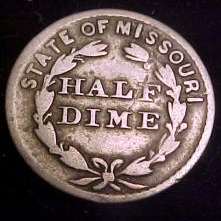

This trade token likely dates to the 1840s and clearly adapts the reverse of the Liberty Seated half dime introduced in 1837. The legend UNITED STATES OF AMERICA is replaced by STATE OF MISSOURI on the reverse. These tokens would have been used to make change at Nicholson’s establishment, and in addition served as an advertising vehicle.
Joe Levine made a remarkable discovery while investigating a similar piece in the Litman hard times token collection (Presidential Coin and Antique Company #72, 12/6/2003). This merchant token, lot 140 in the sale, was previously attributed to a J. B. Wilson in Indianapolis, but, based on the similarity to the Nicholson piece, Levine checked St. Louis city directories for the period. Levine’s hunch was correct! He adds,
“Beginning in the 1853 directory, J(ames) B. Wilson is listed as a baker on Morgan Street between 7th and 8th. In the 1854-5 directory, the ‘James B. Wilson Bakery’ is at 186 Morgan Street and in the 1857 directory, his business is listed as being at 134 and 136 Morgan Street. The 1857 listing is the last in which Mr. Wilson’s name appears.”
Based on Levine’s evidence, it seems certain the Wilson piece originates in St. Louis. The obverse legend of this token reads GOOD AT J. B. WILSON’S FOR, while the reverse is plainly BREAD. The illustrations here from are TokenCatalog.com, courtesy of Mark Borckardt.
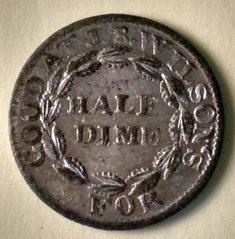
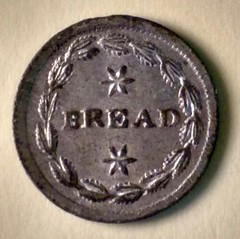
Did the Nicholson and Wilson pieces come from a common manufacturer? Perhaps so, but it is clear the reverse dies differ, for the Nicholson piece has an open wreath with bow, more closely resembling the half dime, while the Wilson piece is a closed wreath with no bow. That both businesses were operated just a few blocks from each other seems more than coincidental. One wonders if a Nicholson piece would have been accepted in payment at Wilson’s bakery, or vice versa. In any case, either of these will sell today for much more than a common date circulated half dime!
For more information on the Liberty Seated Collectors Club, see:
http://www.lsccweb.org/
To read the earlier E-Sylum articles, see:
WANTED: RESEARCH ON HALF DIME TOKENS (http://www.coinbooks.org/esylum_v19n09a15.html)
SOME MORE HALF DIME TOKENS (http://www.coinbooks.org/esylum_v19n10a17.html)
NICHOLSON'S HALF DIME TOKEN (http://www.coinbooks.org/esylum_v19n39a21.html)
COINS FROM THE WOODWORK AT 1901 EXPOSITION
The Western news (Stevensville, Montana). January 29, 1902
Ragged Bills and Smooth Coins Put Into Circulation at
the Pan-American Fair.
There are more ragged old bank bills, government notes and ancient silver coin that have been put into circulation in Buffalo during the Pan-American exposition than have been seen for a quarter of a century, says the New York Times. A searcher after the cause found many cashiers of shows and other places who could give explanations. One money taker of a midway performance said: “It’s simple enough. Farmers from the interior of New York State, Pennsylvania and Ohio have been attracted to the exposition because they could see a big show cheap. They take their hoard of old silver coins and small bills, which have been out of circulation and in their stockings and teapots for years, and turn them loose here. It is hard on the city folks, but the farmers would be insulted if you refused their old coins.”
A cashier of a German resort said: “There are thousands of Germans who came this country and worked hard for years saving their small change. They come here and spend old dimes and quarters saved on the farms as if they were five-dollar bills.”
Another shrewd observer said: “You see, there are thousands of people who come to the exposition who do not fully know the value of coins. Many unscrupulous people are making a business to collect all the battered coin which would be refused in New York and send it here to be [palmed] off on the “hayseeds” and foreigners. Plugged coins which would be refused in New York and which would have to be sold for a large discount find their way here and pass at full face value. Then, again, there are many Canadian people who have battered United States currency which they want to get rid of. It seems as if all the old garrets of this state had been racked to find old bills and coin to be put in circulation during the exposition.” The custom is established at the exposition not to refuse battered coin because it is so easy to pass it through the cash drawer to the next unsuspecting visitor.
Here, we have indication that coins that had long ago been hoarded by farmers in Ohio, Pennsylvania, and upstate New York, were dug out and spent at the Pan American Exposition held at Buffalo, New York, May to November, 1901. It would have been most interesting to see exactly what the concession- aires were taking in. Were they high grade pre-Civil War Liberty Seated coins that had been hoarded 40 years before, or coins from the 1875-1878 retirement of the fractional currency, or possibly coins from the earlier Federal period? Clearly the concessionaires knew to be on the lookout for coins that later could be sold to collectors.
Coins that were holed, engraved or otherwise mutilated were only received by the U. S. Government based on the value of their actual silver weight, not their face value. Post Offices flat refused to accept these coins and most merchants followed suit. Apparently, some enterprising New Yorkers saw an opportunity to gather up these “old maids” on the cheap from the brokers about town and sell them in bulk to the concessionaires at the Exposition. The concessionaires could pass them on in change to the unsuspecting public and the suppliers would make a tidy profit on the spread. Apparently, “hayseeds” were in abundance back in 1901.
For more information on the Liberty Seated Collectors Club, see:
http://www.lsccweb.org/

ARCHIVES INTERNATIONAL SALE 44 ANNOUNCED
U.S., CHINESE, MIDDLE EASTERN AND WORLDWIDE BANKNOTES SCRIPOPHILY, COINS AND SECURITY PRINTING EPHEMERA WILL BE OFFERED IN 2 SESSIONS AT PUBLIC AUCTION ON TUESDAY, AUGUST 29th , 2017
The auction will be held by Archives International Auctions, at their offices in Fort Lee, N.J.
 The August auction, consisting of 974 lots, will feature an extensive collection of Chinese banknote rarities including additional items from the Pogrebetsky Family Archives; Middle Eastern
banknotes from Iraq, Lebanon, Jordan, Morocco and numerous other countries; an exciting assortment of U.S. Obsolete banknotes, 3 different uncut Confederate banknote sheets as well as hundreds of
other desirable banknotes, coins, bonds and shares.
The August auction, consisting of 974 lots, will feature an extensive collection of Chinese banknote rarities including additional items from the Pogrebetsky Family Archives; Middle Eastern
banknotes from Iraq, Lebanon, Jordan, Morocco and numerous other countries; an exciting assortment of U.S. Obsolete banknotes, 3 different uncut Confederate banknote sheets as well as hundreds of
other desirable banknotes, coins, bonds and shares.
The first session includes 623 lots of Chinese, Middle Eastern and Worldwide banknotes, coins, and Chinese Scripophily, beginning at 10:30 AM EST. The second session will include 350 lots of U.S. Banknotes, Scripophily, Security Printing Ephemera and historic that will begin no earlier than 4:00 PM local time after the first session has ended. For those unable to attend in person, online bidding will be available through the website, www.ArchivesInternational.com.
“The worldwide banknote market has been exceptional this last year with dozens of price records being set every sale. We do our best to cater to every level of collector and dealer and look forward to another exciting auction that includes hundreds of worldwide banknotes, coins and scripophily,” said Dr. Robert Schwartz, president of Archives International Auctions.
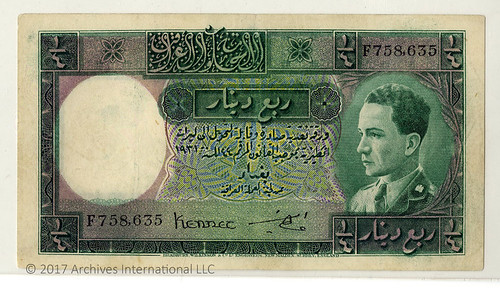
Highlights from Session 1, will begin with 223 lots of Chinese banknotes, coins and scripophily with highlights featuring an issued Deutsch-Asiatische Bank, 1907, $5 “Shanghai” Branch Issue rarity; a Russo-Asiatic Bank, “Kuld'sha, Chuguchak & Kashgar Branch” issued 1913-17, 1 Gold Fen Issue that is rarely seen at auction; an exceptional collection of 50+ early Communist China era private scrip notes from many issuers that have not been seen previously at auction and will be sure to attract attention from serious collectors; as well as dozens of other exciting and rare Chinese banknotes; Also included are over 50 lots of Chinese Scripophily, bonds and shares.
Worldwide banknotes feature over 270 lots of rare and desirable notes from all over the globe featuring a collection of rare Middle Eastern issued and specimen notes highlighted by a Government of Iraq, 1935, ¼ Dinar issued King Ghazi banknote rarity as well as 14 other early Iraq issued and specimen notes ca.1935 to 1986 with the majority dating between 1942 and 1959; Morocco is also represented by an extensive group of mostly specimen banknotes that offers many highlights including 1938 Banque d'Etat du Maroc, 5000 Franc specimen and numerous other desirable issues; Italy is represented by a comprehensive collection of early Italian States banknotes and coins put together over many years by a serious collector that would be difficult to assemble today. We are also presenting Part 2 of the Arthur C. Matz Collection of post 1960 modern banknotes with many rarities and complete date and signature varieties which would be nearly impossible to duplicate today. German South West Africa is represented by 4 scarce scrip notes from the Silicon Valley Collection.
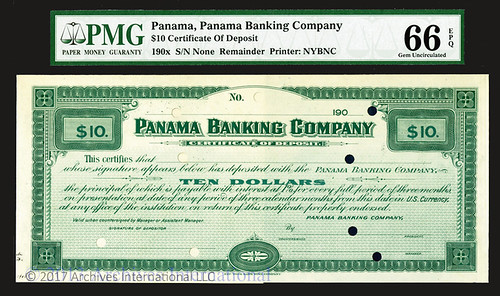
Highlighting the worldwide banknote section is a historic and very possibly unique set of 4 different ca.1907-1908 Panama Banking Company Circulating Certificate of Deposit specimens found in a rare New York Bank Note Company sample book. Denominations include $10; $20; $50 and $100 denominations. The Panama Banking Company had branches in the cities of Panama and Colon at both entrances of the Panama Canal (Balboa and Cristobal, Canal Zone) to do a general banking business and were fully equipped for the transaction of all financial business in the Republic of Panama and the Canal Zone. This set preceded the listed Republic of Panama 1930-40 issued notes by 25 years.
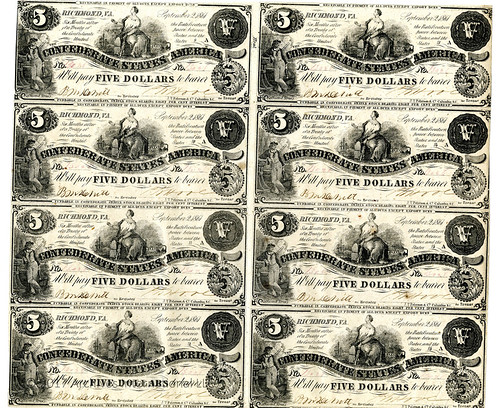
Session 2 of the auction includes U.S. & Worldwide Banknotes, Scripophily, Coins, and Security Printing Ephemera. Highlights include 3 different uncut Confederate banknote sheets of 8 notes, an 1861, $5 Sheet, T-36; a $20 Sheet, T-18 PF1; and an 1864, $10 Sheet, T-68; dozens of additional banknotes including Obsolete, Colonial, Small and Large Type Notes are included in the sale.

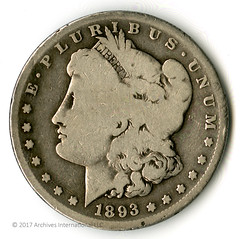
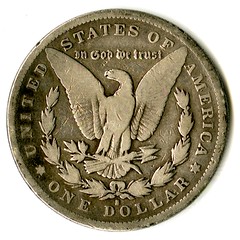
U. S. coins include a nearly complete set of 122 U.S. Silver Dollars, comprised of 98 Morgan dollars and 24 Peace dollars with highlights including an 1893-S dollar in Almost Good to Good condition; 1889- CC, F-VF; 1878-P, 7 TF, CU to Gem Unc. and numerous other coins; the sale ends with over 200 lots of rare and desirable scripophily.
The auction will feature hundreds of additional rare and desirable banknotes, coins, and scripophily in every price range, for the beginner to the advanced collector. Previews will be held at Archives International Auctions offices Wednesday to Friday, August 23 rd to 25 th from 10 AM to 5 PM and by appointment. For an appointment call 201-944- 4800 or email info@archivesinternational.com.
The Online catalog for the August 29 th sale is on Archives International Auctions’ website and can be viewed via the Archives International live bidding platform. It can also be viewed as a virtual catalog or downloadable .pdf on their website. To pre-register for live internet bidding, log on to the Archives International Auctions website, at www.ArchivesInternational.com.
Archives International Auctions is currently seeking quality consignments for future auctions and is looking for U.S. and worldwide banknotes, coins, stocks, bonds, stamps, postal history, historic ephemera, autographs, and documents to buy outright. To sell or consign one piece or an entire collection, please call AIA at (201) 944-4800; or e-mail them at info@archivesinternational.com.
You may also write to Archives International Auctions, at 1580 Lemoine Ave., Suite #7, Fort Lee, NJ 07024 U.S.A. To learn more about Archives International Auctions and the auctions planned April 11 th , 2017, log on to www.ArchivesInternational.com.
Links:
https://archivesinternational.com/
First Session
(http://auction.archivesinternational.com/AIA-Sale-44-U-S-Worldwide-Banknotes-Scripophily-Coins-Ephemera-August-29th-2017_as48636)
Second Session
(http://auction.archivesinternational.com/AIA-Sale-44-U-S-Worldwide-Banknotes-Scripophily-Coins-Ephemera-August-29th-2017_as48636_p13)
Online Catalog (http://auction.archivesinternational.com/auctionlist.aspx)
Downloadable .pdf (http://archivesinternational.net/AIA44_flow5Catalogr.pdf)
THE BOOK BAZARRE
WAYNE'S NUMISMATIC DIARY: AUGUST 6, 2017, PART 1
I had a great trip to the American Numismatic Association World's Fair of Money in Denver this week. Here's what I did, told mainly in photos.
WEDNESDAY, AUGUST 2ND
Wednesday was a travel day for me. United Airlines moved my flight up a couple hours due to an incoming weather system, so I went into work in the morning but headed back out again for the airport
after a couple hours.
We bounced around a good bit through turbulence on our descent into Denver, and it gave me a bit of a headache. I grabbed a sandwich for dinner at the airport and hopped a shuttle to my hotel, the Sheraton. Stepping onto the sidewalk I immediately ran into and chatted with ANA Executive Director Kim Kiick.
Except for checking email, that was the extent of my numismatic activity for the day.
THURSDAY, AUGUST 3RD
Still on East Coast time, I woke up at 4am and set to work on The E-Sylum. With travel and convention events taking up so much time this week I wanted to get a head start. With short breaks
for my morning routine and breakfast at 6am, I worked until around 10.
Setting off for the convention center, I walked back and forth before finally getting my bearings - it was about four blocks away and out of sight from the hotel.
The Colorado Convention Center has a whimsical sculpture of a three-story tall bear peeking in the window. I texted a picture to my daughter back home, who thought it was cool.
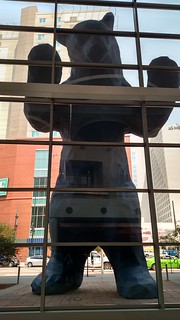
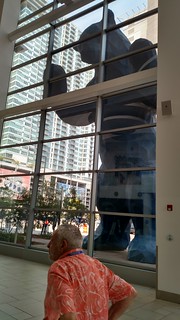
I ran into NBS Board member John W. Adams on the way to registration and stopped to say hello. But I was running late to meet up with E-Sylum subscriber Martin Kaplan. We'd never met in person. We found each other right away and had a nice chat, planning to get together again later that morning.
I made my way up to the registration desk and spoke to ANA Membership manager Cary Hardy. He kindly lent me a lanyard since I'd forgotten mine (and my convention ribbons) back in the hotel.
The first U.S. Coin
I quickly ran into Don Kagin who offered to show me the 1783 plain obverse Nova Constellatio Quint pattern featured at his table - see the article earlier in this issue for more information. He and
the burly guard stationed next to it opened the display case and got the coin out so I could hold it. Here's Don posing with it.
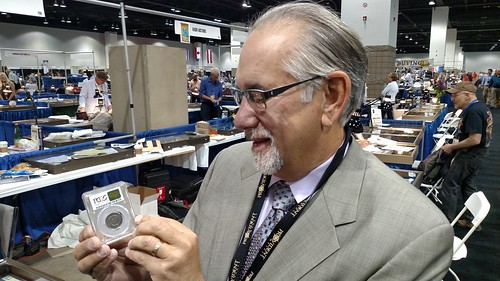
Legend Numismatics
The Legend Numismatics table was right up front. I stopped to thank them for their recent advertising support and admire their displays.
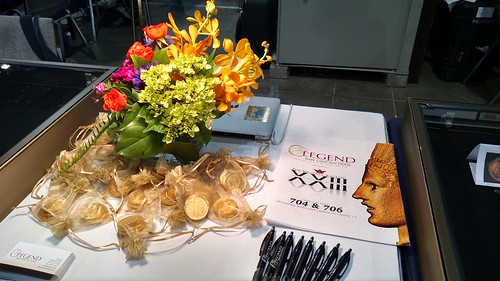
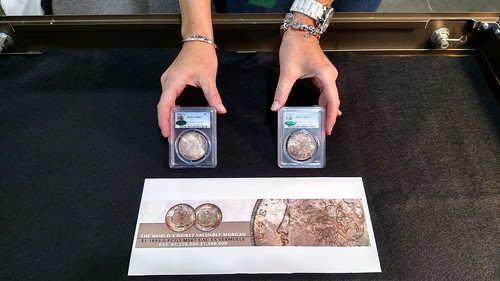
An employee opened the case so I could get a photo without glare. Take a close look at the spelling, an intentional attention-getting mistake.
Paul Bosco
Here's a candid shot of medal dealer Paul Bosco. Like many dealers at the show he was busy with customers and I didn't get a chance to talk.
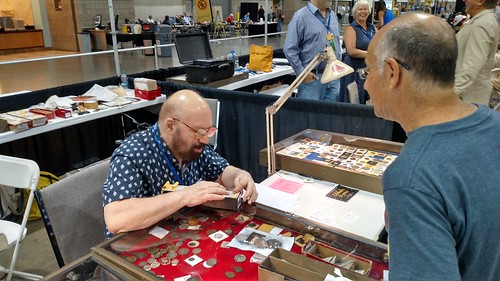
Charlie Davis
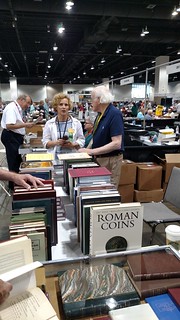 Next I made my way to the table of numismatic literature dealer Charlie Davis, where he was speaking with Ute Wartenberg Kagan, Executive Director of the American Numismatic Society. Here
they are at right.
Next I made my way to the table of numismatic literature dealer Charlie Davis, where he was speaking with Ute Wartenberg Kagan, Executive Director of the American Numismatic Society. Here
they are at right.
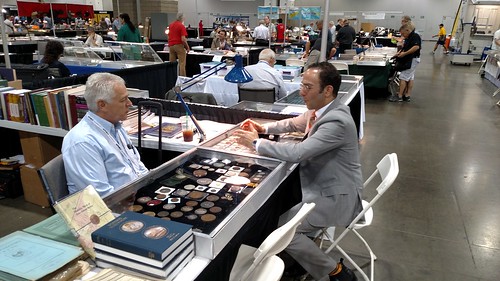
Neil Musante speaking with Vicken Vegparian
While at Charlie's table I spoke with Numismatic Bibliomania Society legends P. Scott Rubin and George Kolbe. Scott was a Board member for decades, and George cofounded our group with the late Jack Collins.

P. Scott Rubin and George Kolbe
I spoke a bit with George about the changing market for numismatic literature. We both recall the days before the internet when individual bookshops and the industry publication AB Bookman ruled the book world.
One of the first books I bid on in numismatic literature sales was a corporate history of the American Bank Note Company by William Griffiths. Illustrated with real engravings, the book regularly brought $100 in numismatic literature sales. I didn't want to pay that much, and regularly got outbid.
I was living and working in Pittsburgh at the time, and read about a used and rare bookstore that had opened up on the South Side. I called them up and asked if they had any titles on coins or paper money. When they read off the title of the ABNCO book and said it was priced at $5, I told them to hold it and I'd come over at lunchtime.
George told me he would regularly buy these from used booksellers and resell them at a profit in the numismatic market. I was a fast learner and had put my own ads in AB Bookman and bought and sold several of these myself. George also recounted how we could regularly buy ANS Numismatic Notes and Monograph titles in the U.S. and resell them at a good profit overseas. Those were the days.
Garrett Ziss
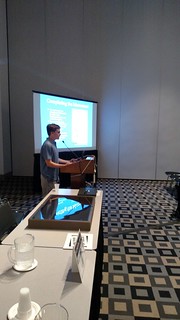 Around 11 o'clock I found the Money Talks room and entered to hear part of a talk by young numismatist Garrett Ziss on the coins found in the time capsules recovered from the Washington
Monument in Baltimore. I took a seat in the front row between Joel Orosz and Len Augsburger. Garrett did a great job, but the three of us had to duck out early for the NBS Board Meeting.
Around 11 o'clock I found the Money Talks room and entered to hear part of a talk by young numismatist Garrett Ziss on the coins found in the time capsules recovered from the Washington
Monument in Baltimore. I took a seat in the front row between Joel Orosz and Len Augsburger. Garrett did a great job, but the three of us had to duck out early for the NBS Board Meeting.
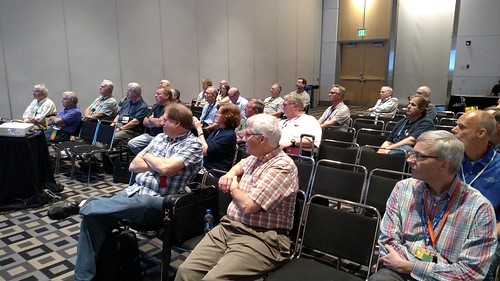
NBS Board Meeting
The annual Board Meeting of the Numismatic Bibliomania Society took place at 11:30. Before we got started, I introduced Martin Kaplan to the board and thanked him for his promotional work which was
responsible for a large part of our recent E-Sylum subscriber increases this year. I'd asked him to come in to take a bow, and he got applause from the group. Thanks, Martin!
Next it was time to get to work. Here the officers are reviewing the treasurer's report.
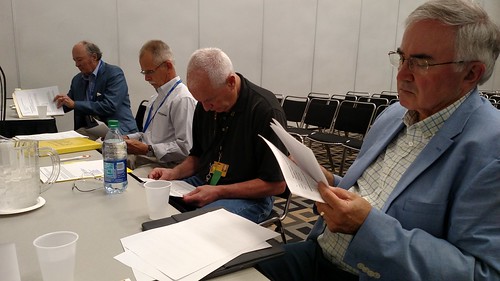
John Adams, Tom Harrison, Dave Perkins, David Sundman
"Hmm, what's this 'Slush Fund for Personal Numismatic Literature Purchases'...?"
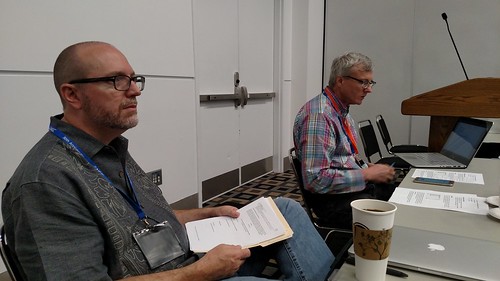
David Fanning, Len Augsburger
There's no slush fund, but club finances are tight. With the proceeds from the fundraising auction we'll probably be OK this year, but everyone reading this can help by joining or sending in their dues, taking out an ad in The Asylum, or making a donation.
NBS Symposium: Neil Musante
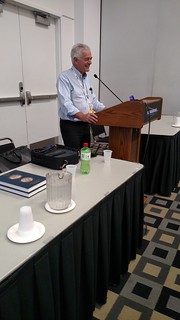 Right after the Board meeting it was time for the annual NBS Symposium. On the way there I ran into Tom Wetter and his wife. Tom has labored long and hard on the NBS web site Wiki,
compiling great pages of information on U.S. auction catalogs. He had a sad but funny story about the fate of one of his antiquarian numismatic books after his dog realized that vellum is just a
tasty 300-year-old piece of beef jerky.
Right after the Board meeting it was time for the annual NBS Symposium. On the way there I ran into Tom Wetter and his wife. Tom has labored long and hard on the NBS web site Wiki,
compiling great pages of information on U.S. auction catalogs. He had a sad but funny story about the fate of one of his antiquarian numismatic books after his dog realized that vellum is just a
tasty 300-year-old piece of beef jerky.
This year's speaker was Neil Musante, author of Medalllic Washington and The Medallic Work of John Adams Bolen. Here's Neil at the podium.
Tokens & Medals Symposium
On May 28, 2017 Susan Trask wrote:
The Civil War Token Society (CWTS), Token and Medal Society (TAMS) and Medal Collectors of America (MCA) are hosting a Money Talks presentation on Thursday, 3:00 pm at the American Numismatic Association in Denver this August titled ASK THE EXPERTS! A SYMPOSIUM ON THE ALLURE OF TOKENS AND MEDALS. I'm moderating a panel featuring David Schenkman, Bill Hyder, Steve Hayden, Neil Musante and Q. David Bowers. We would love your readers to submit their questions for the event to me via email at susantrask@mindspring.com or write to me at P.O. Box 2053, Sister, Or. 97759.
The long-awaited event took place at 3pm Thursday in Room 501.
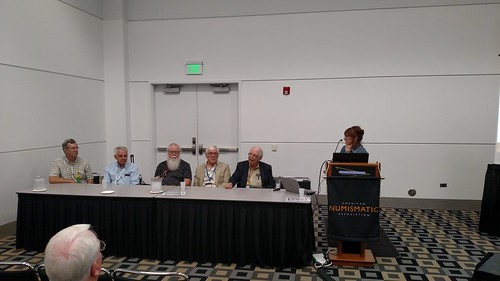
Hayden, Musante, Hyder, Schenkman, Bowers; Trask at podium
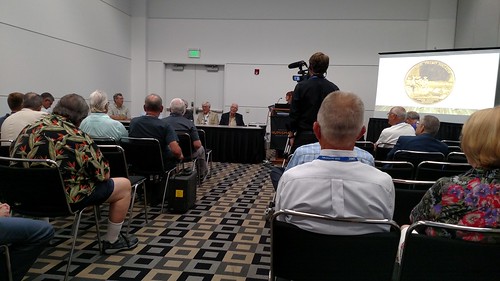
To read the earlier E-Sylum articles, see:
NOTES FROM E-SYLUM READERS: MAY 28, 2017 : Symposium On The Allure Of Tokens And Medals
(http://www.coinbooks.org/v20/esylum_v20n22a14.html)
THE ALLURE OF THE TOKEN AND MEDAL SOCIETY (http://www.coinbooks.org/v20/esylum_v20n23a12.html)
1792 Author's Table
At 3:30 the merry band of authors was present at the Heritage booth to sign and sell copies of 1792: Birth of a Nation's Coinage. While visiting several folks came by, including Kellen
Hoard. I also got to meet and share a laugh with reader Rob Rodriguez who pulled out a Continental Dollar for me to hold and examine.
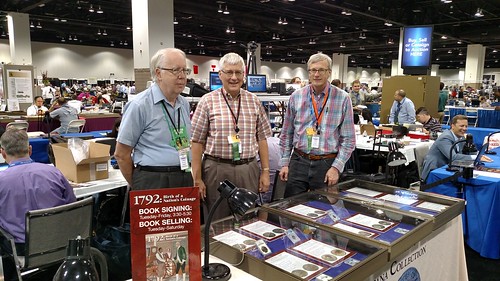
Right next to the authors was a display of the Resolute Americana collection of 1792 coinage and related items.
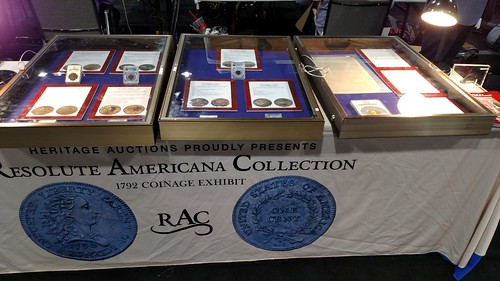
More Novas
On a jaunt round the bourse floor I stopped for a quick look at the Nova Constellatio patterns on display at Kevin Lipton's table.
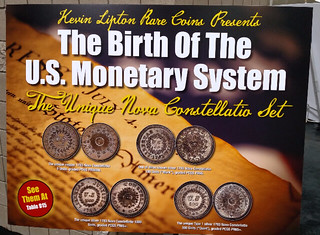
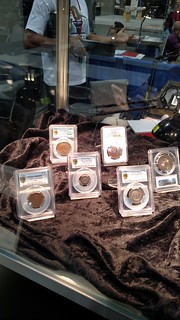
BEP Damaged Banknotes Display
We've often discussed the Bureau of Engraving and Printing's efforts to reimburse citizens for destroyed paper money. The BEP had a nice exhibit of the different types of damage notes can
sustain.
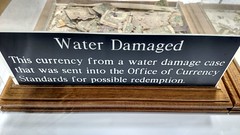
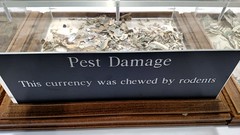
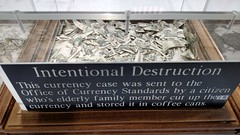
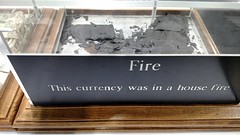
Chet Krause Silent Auction
One table displayed items of numismatic show memorabilia from the estate of the late Chet Krause, founder of Numismatic News. A wide array of badges, buttons, ribbons and medals was
offered.

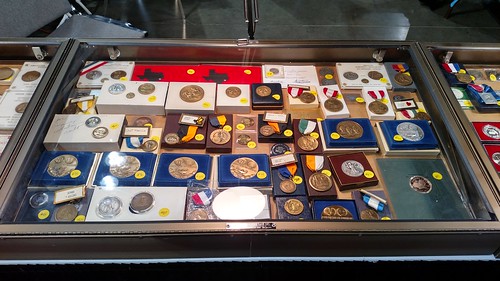
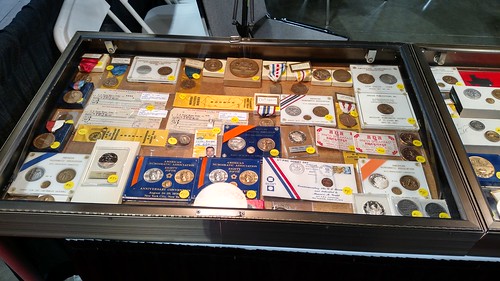
Attinelli Fellowship Dinner
The inaugural annual dinner of the Attinelli Fellowship took place Thursday evening at Marlowe’s Saloon & Chophouse.
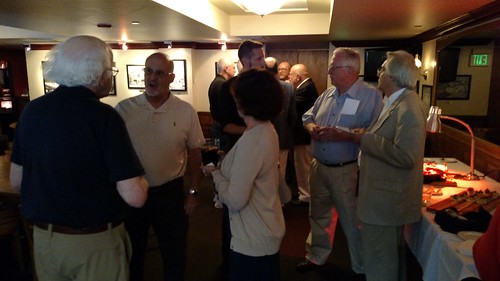
Foreground: Charlie Davis, Scott Rubin, Scott' wife, Tom Sheehan, John Lupia;
In back: George Kolbe at right
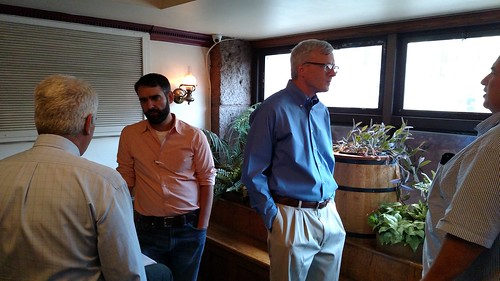
Neil Musante, John Kraljevich, Len Augsburger, Roger Siboni

Joel Orosz, Dave Perkins, David Fanning, John Adams
Note to self: letting waiters and your friends refill your wine glass like it's water leads to the consumption of a great deal of wine. As I later heard John Adams remark in a different context, "a little bit of Pinot Noir goes a long way."
So as much as I hated to leave, it was probably a Good Thing that I had to duck out around 9pm to go back to the Sheraton for the NLG Bash. Joel, Len and Deb had already done the same ahead of me.
NLG Bash
Our sister organization the Numismatic Literary Guild (NLG) holds an annual banquet and awards ceremony called the NLG Bash every year as part of the ANA convention.
I was surprised and honored to learn that The E-Sylum had won the PCGS Education Award. Len's wife Deb Kurtz took these photos. I was asked to say a few words at the podium.
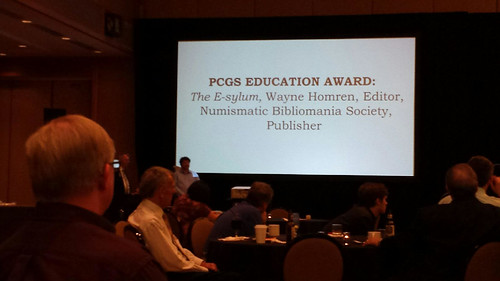
"Hey, that's me!"
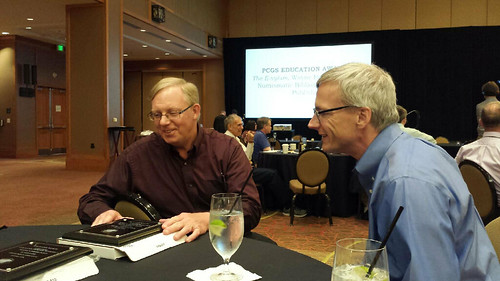
Wayne and Len Augsburger review the E-Sylum award plaques
The Book of the Year award went to 1792: Birth of a Nation's Coinage
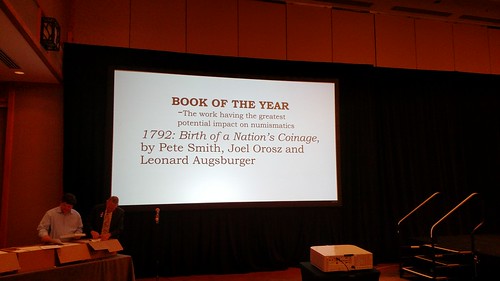
That's Charles Morgan of CoinWeek and Joe Boling preparing winner plaques.
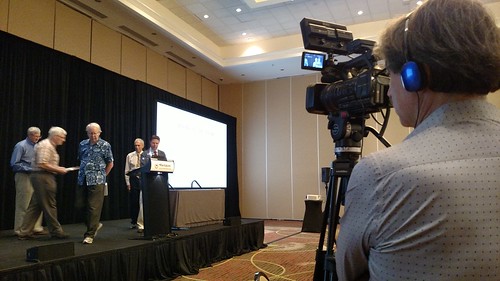
In this shot camerman David Lisot records authors Len Augsburger, Joel Orosz and Pete Smith making acceptance speeches. At the podium are Maurice Rosen and Scott Travers of NLG.

WAYNE'S NUMISMATIC DIARY: AUGUST 6, 2017, PART 2
FRIDAY, AUGUST 4TH
On Friday I again spent the morning at the Sheraton working on email and The E-Sylum. The Pinot Noir was clogging my head, and I dragged all day long.
NBS General Meeting
My first stop was the annual General Meeting of the Numismatic Bibliomania Society at 11:30. When I arrived David Fanning and new President Tom Harrison were busily setting up the room and auction
lots.
Tom called the meeting to order and the audience took turns standing to introduce themselves and discuss their literature collecting interests. Next, Tom presented some awards, including the Jack Collins Award for Best New Author in The Asylum, which went to Shanna Schmidt.

Paul Hybert introduces hmself
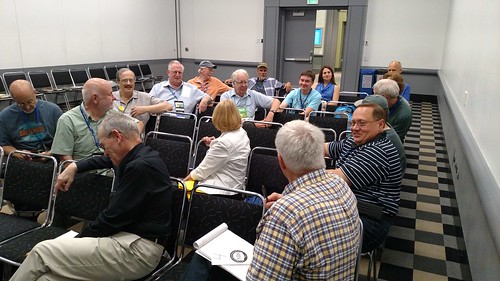
Crowd listens to a question

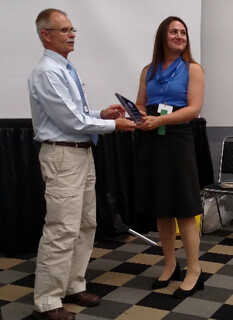
Left: Tom Harrison with his dapper NBS-logo tie
Right: Tom Harrison presents Jack Collins award to Shanna Schmidt
After the awards I gave about an 18-minute overview of the process of creating The E-Sylum each week - not the buttonology so much as the decision and workflow process. I begin each week with a skeleton template and gradually fill it in as articles and emails come my way. I discussed the priority and ordering of articles, with NBS news first, followed by literature sales, new books and book reviews.
Next up was the auction. Tom had prepared bidder paddles. Since I was sitting right up front, I was able to secure bidder #1. I really wanted to bid on the deluxe version of Neil Musante's book, but all of us in the room got skunked by an absentee bidder. I took home two lots, the ANA Centennial volume and the Douglas book on New Jersey Coppers. I didn't have the latter, and the former was going to cheap to let pass.
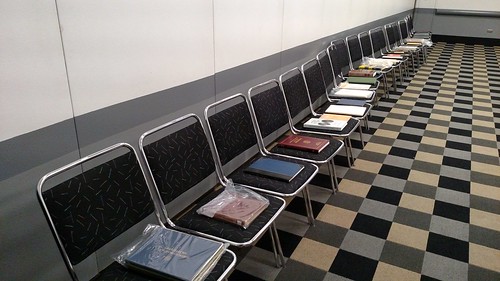
Left: Auction lots displayed
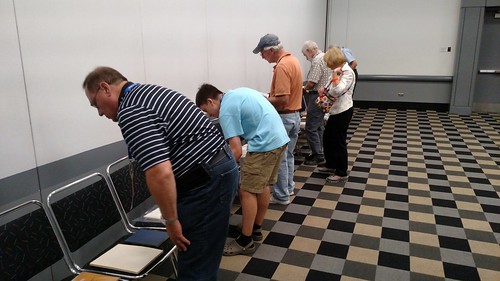
Right: Prospective bidders examine lots
Not even Tom's tie was safe - that too was auctioned off to the highest bidder. Over $3,500 was raised for the NBS Treasury.
1792 Presentation
After the NBS meeting I went back to the bourse for a bit. I ended up across the street at Stout Street Social for a very quick lunch of grilled chicken salad. Next it was back to the convention
meeting rooms for the Money Talks presentation by the team behind 1792: Birth of a Nation's Coinage.
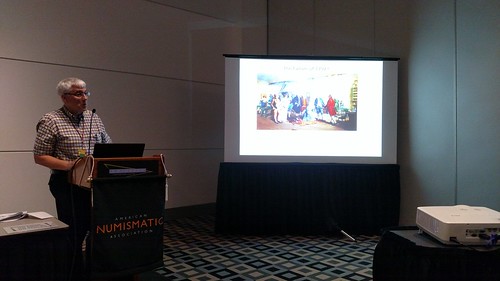
Joel Orosz explaining one of the book's paintings by John Ward Dunsmore
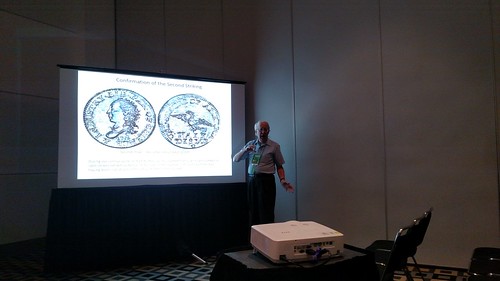
Pete Smith explaining 2nd striking diagnostics
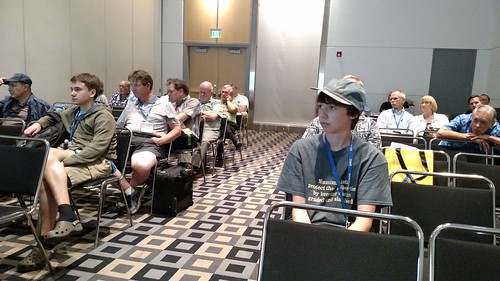
Young numismatists Garrett Ziss and Kellen Hoard up front
Whitman Booth
My next stop was the Whitman Publications booth, where the star of the show was Dennis Tucker's alternately chirpy and shy daughter. At left are Ken Bressett and Whitman's Mary Burleson.
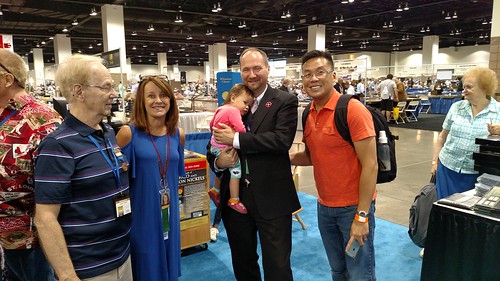
Proud Papa Dennis forwarded these two additional photos.
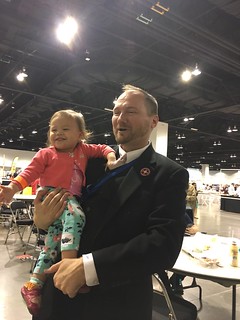

Exhibits
The clock was ticking and I made a sprint through the exhibit area. There were some great exhibits, some of which I'd seen earlier in the year at Central States. Here are a few that caught my eye
this time around.

Women on Confederate Money
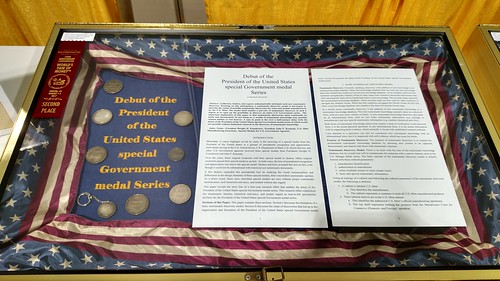
The Special Government Medal
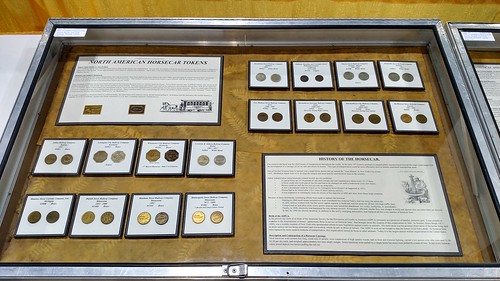
North American Horescar Tokens, Case 1
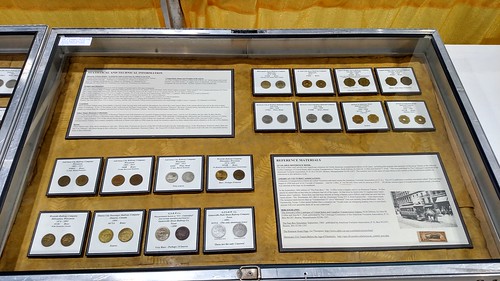
North American Horescar Tokens, Case 2
I was especially wowed by the Horsecar token exhibit, and gave it my vote for People's Choice. Some of these are extremely rare, and I'd never seen so many at once in my life.
Siege Money
My friend Dr, Lawrence Korchnak presented a talk on paper siege currency at 4pm. He had some of these rare pieces on display.
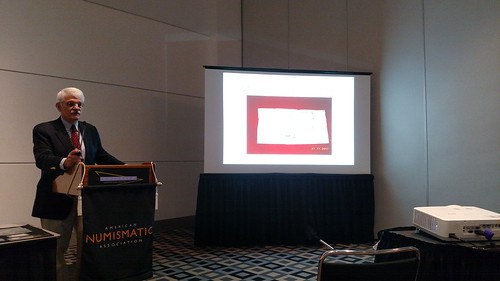
Larry's working on a book based on his many years of collecting and studying siege money, both coins and paper. If anyone is interested in or can contribute to the work, let me know and I'll put you in touch.
Lesher Dollar Exhibit
I couldn't leave the show without checking out the Lesher dollar exhibit.
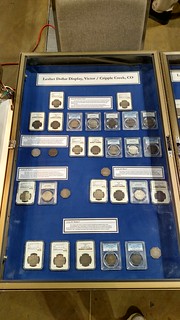

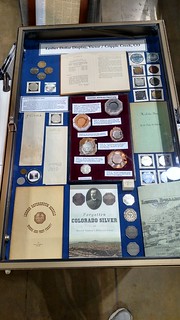
An amazing grouping. I enjoyed seeing the literature of Lesher Dollars, including the new book by Bob Leonard.
To read the earlier E-Sylum article, see: LESHER DOLLAR COLLECTION EXHIBIT (http://www.coinbooks.org/v20/esylum_v20n31a18.html)
NGC Continental Dollar Display
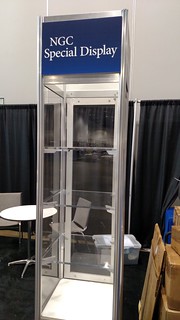
I arrived a little too late to see the Continental Dollar exhibit at the NGC Booth. I got a nice consolation prize when Dave Lange gave me a slabbed 2017-D Kennedy Half. A number of these were prepared for the evening's ANA Awards Banquet,where Dave received the Numismatist of the Year honor.
Dinner With Kellen
After a jaunt back to the hotel to change I set out again for the Bistro Vendome restaurant, where me, Joel, Len Augsburger and his wife Deb Kurtz were having dinner with Kellen Hoard and his Mom
Cathy. I said hello as I passed Julian Leidman on the street and hopped on the 16th Street Mall bus to Larimore Street.
The restaurant was tucked away in a courtyard, New Orleans style. The rest of our party was already seated. We had great conversation about the events of the convention, Kellen's recent trip to the ANA Summer Seminar, numismatic luminaries, and the future of the hobby. Here's a group shot taken afterwards by Kellen's Mom.
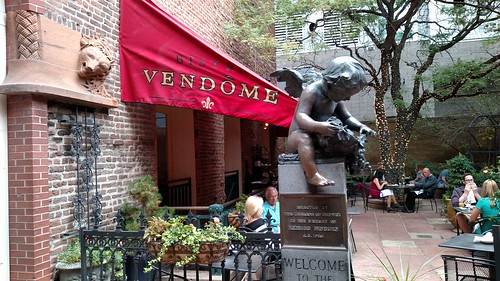
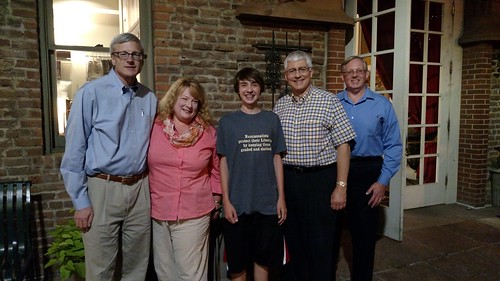
Len, Deb, Kellen, Joel, Wayne

WAYNE'S NUMISMATIC DIARY: AUGUST 6, 2017, PART 3
SATURDAY, AUGUST 5TH
Rittenhouse Breakfast
7:30am Saturday brought the Rittenhouse Society annual breakfast meeting. On the way there I ran into Paul Gilkes of Coin World and we chatted a bit about the show and our hectic
schedules.
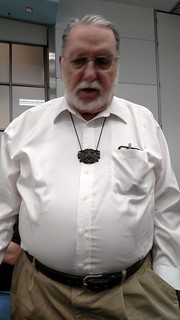 The Rittenhouse society was started in October 1959. Among the founding members were Ken Bressett and Dave Bowers, both of whom were in attendance in Denver. Membership is by invitation
only, by a vote of current members. Following a buffet breakfast each member stands to introduce themselves and mention current research projects they are working on. It's a fascinating glimpse
into where numismatic research and publication is going. Here are some of the photos I took.
The Rittenhouse society was started in October 1959. Among the founding members were Ken Bressett and Dave Bowers, both of whom were in attendance in Denver. Membership is by invitation
only, by a vote of current members. Following a buffet breakfast each member stands to introduce themselves and mention current research projects they are working on. It's a fascinating glimpse
into where numismatic research and publication is going. Here are some of the photos I took.
At right is David T. Alexander, proudly wearing his Society of Bearded Numismatists medal as a clasp on a bolo tie. David was seated next to me. At our table was Tom DeLorey, who was also wearing one of the medals.
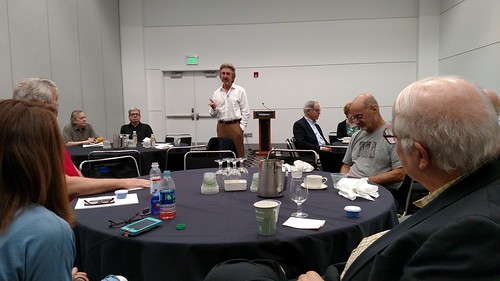
Jeff Garrett standing; Mary Burleson and Dave Bowers in foreground
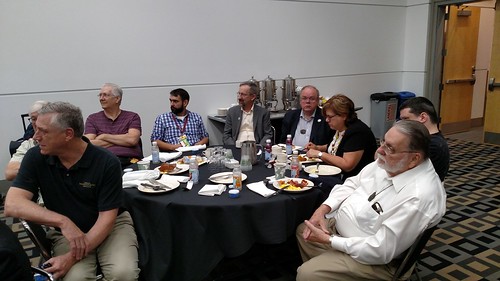
Here's my table. Clockwise from left: Doug Mudd, ANA Museum Director, Dave Schenkman, John Dannreuther, John Kraljevich, Mark Borckardt, Tom DeLorey and wife, Christopher and David Alexander.
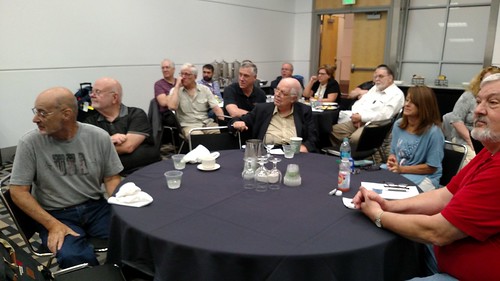
Here's Dave Bowers' table. Clockwise from left: P. Scott Rubin, George Kolbe, Dave, Mary Burleson, Ray Williams. Except for the first one of Dave and Mary, the remaining photos are by Mary Burleson.
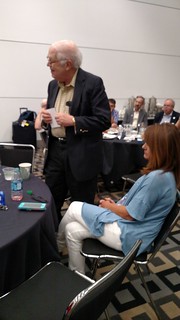
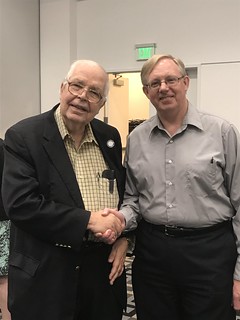
Dave and Mary; Dave and Wayne
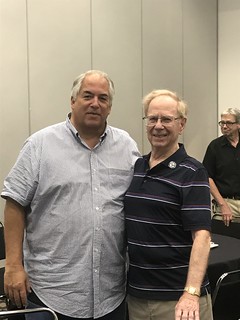

Roger Siboni and Ken Bressett; Bob Van Ryzin and Barbara Gregory
Before we broke up Mary stood up on a chair to get a group photo. Roger Burdette, having worked as a professional photographer at one point, herded the cats and got us all standing and facing for a proper portrait.
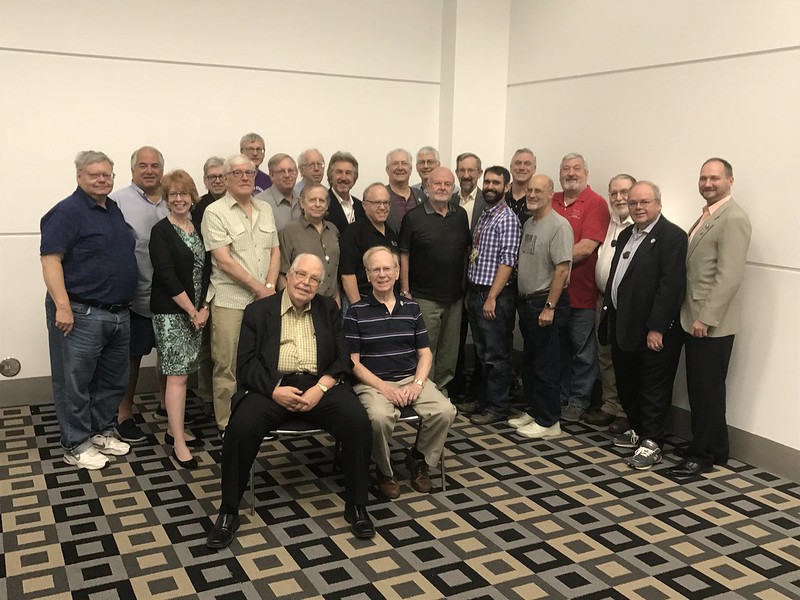
Seated: Q. David Bowers, Ken Bressett
1st standing row: Barbara Gregory, Dave Schenkman, Phil Bressett, david Lange, George Kolbe, John Kraljevich, P. Scott Rubin, Tom DeLorey
2nd standing row: Roger Burdette, Roger Siboni, Robert Van Ryzin, Len Augsburger, Wayne Homren, Pete Smith, Jeff Garrett, John Dannreuther, Joel Orosz, Mark Borckardt, Doug Mudd, Ray Williams,
David T. Alexander, Dennis Tucker
What a great gathering of numismatic researchers and writers!
On the way out I chatted with Scott Rubin and George Kolbe. Later I ran into John Lupia and Barbara Gregory. Was that Rob Rodriguez who waved at me from across the street?
I made my way back to the Sheraton, stopping in the 7-11 downstairs for a fountain drink. It came to $1.69 and I had exactly $1.53 cash, in the form of a lonely one-dollar bill and some pocket change. It seemed silly to use a debit card for such a small purchase, but I did. One more nail in the coffin of coinage.
I finished packing and waited outside for my airport shuttle. While sitting in the van waiting to pull out I saw Ken and Phil Bressett entering the hotel. What a great convention it had been. It was so nice to see everyone and enjoy our hobby together. At the airport I stopped at an ATM to replenish my cash, grabbed some lunch and got on my plane. I passed a seated Roger Burdette as I made my way back to my own seat in the cheap section. We completed our journey safely and I was back home by 7pm Saturday. See you next time, everyone!
NOTE: Of course, I ran into many others during the convention, including Jan Monroe, Dave Baldwin, Jim Neiswinter, Jan Valentine, Gawain O'Conner, Nancy Wilson, Bob Hurst, Cindy Wibker, Larry Gaye, Skyler Liechty, Jim Halperin, Bob Leonard and Greg Ruby. It was so great to see everyone, if only briefly. If I could choose a superpower, it might be the ability to be in two places at once.
ARCHAEOLOGISTS FIND PICTISH REMAINS
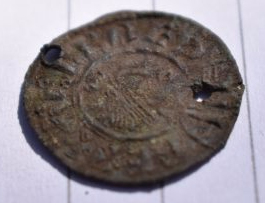 Archaeologists from the University of Aberdeen uncovered a longhouse and an 1,100-year-old anglo Saxon coin in a dig at Burghead Fort near Lossiemouth, Moray.
Archaeologists from the University of Aberdeen uncovered a longhouse and an 1,100-year-old anglo Saxon coin in a dig at Burghead Fort near Lossiemouth, Moray.
Experts believe the fort was a significant seat of power within the Pictish Kingdom, dating between 500AD and 1000AD.
The university team uncovered a Pictish longhouse, within which an anglo Saxon coin of Alfred the Great was found, providing key dating evidence for the use of the house and fort.
Archaeologists said the coin dates to the late ninth century when Viking raiders and settlers were leading to major changes within Pictish society.
Dr Gordon Noble, senior lecturer at the University of Aberdeen, said: “The assumption has always been that there was nothing left at Burghead; that it was all trashed in the 19th century but nobody’s really looked at the interior to see if there’s anything that survives inside the fort.
“This is important because Burghead is likely to have been one of the key royal centres of northern Pictland and understanding the nature of settlement within the fort is key to understanding how power was materialised within these important fortified sites.
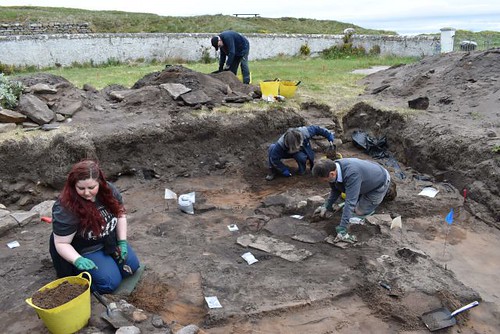
“There is a lovely stone-built hearth in one end of the building and the Anglo-Saxon coin shows the building dates towards the end of the use of the fort based on previous dating.
“The coin is also interesting as it shows that the fort occupants were able to tap into long-distance trade networks.
“The coin is also pierced, perhaps for wearing; it shows that the occupants of the fort in this non-monetary economy literally wore their wealth.
To read the complete article, see:
Archaeologists find Pictish remains at Moray fort
(http://www.swindonadvertiser.co.uk/news/national/15431648.
Archaeologists_find_Pictish_remains_at_Moray_fort/)

ASTRONOMER MARIA MITCHELL’S GOLD MEDAL
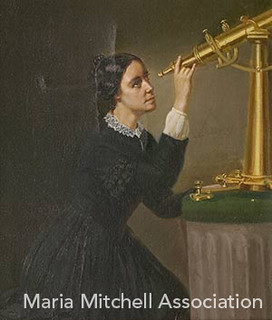 Today is the birthday of Maria Mitchell, the first acknowledged female astronomer, born in 1818 on the island of Nantucket in Massachusetts.
Today is the birthday of Maria Mitchell, the first acknowledged female astronomer, born in 1818 on the island of Nantucket in Massachusetts.
Maria's early interest in science and the stars came from her father, a dedicated amateur astronomer who shared with all his children what he saw as physical evidence of God in the natural world, although Maria was the only child interested enough to learn the mathematics of astronomy.
By age 12, Maria was assisting her father with his astronomical observations and data, and just five years later opened and ran her own school for girls, training them in the sciences and math. In 1838, she became the librarian of the Nantucket Atheneum and began spending her evenings in an observatory her father had built atop the town's bank.
On October 1, 1848, a crisp, clear autumn evening, Maria focused her father's telescope on a distant star. The light was faint and blurry, and Maria suddenly realized she was looking not at a star, but a comet; she recorded its coordinates, and when she saw the next night that the fuzzy light had moved, she was sure. Maria shared her discovery with her father, who wrote to the Harvard Observatory, who in turn passed her name on to the king of Denmark, who had pledged a gold medal to the first person to discover a comet so distant that it could only be seen through a telescope. Maria was awarded the medal the following year, and the comet became known as "Miss Mitchell's Comet."
To read the complete article, see:
TUESDAY Aug. 1, 2017 (http://writersalmanac.org/episodes/20170801/)
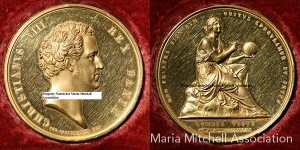
An amateur astronomer himself, Frederick VI, the King of Denmark, decided to offer a gold medal to the first observer to see any new telescopic comet. Frederick VI died in 1839, but his son, Christian VIII, continued to award these medals. Maria was almost denied her medal because William Bond and her father failed to follow the proper procedure for alerting the Danish government of Maria’s discovery. However, more than a year later, the gold medal finally arrived on Nantucket.
The discovery of the comet, Comet 1847-VI informally known as “Miss Mitchell’s Comet,” was the event that made Maria famous. She was elected a member of the American Academy of Arts and Sciences, in 1848 as a result. Maria’s father William Mitchell was already a member.
The gold medal is today a part of the Maria Mitchell collections.
To read the complete article, see:
Maria Mitchell’s Gold Medal (https://www.mariamitchell.org/about/awards/maria-mitchells-gold-medal)


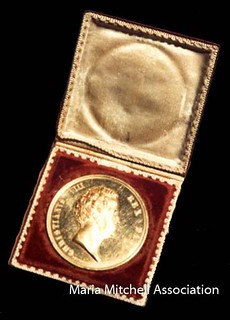 This coin is actually too big to flip; it is a solid gold medal presented to Maria Mitchell in 1848 for her discovery of Mitchell’s Comet in 1847. One side of the medal presents a portrait
of the King of Denmark while the reverse depicts the Goddess of Urania, muse of astronomy. Urania has a globe in her left hand and a stylus in her right. Above her are the words (in Latin) “Not in
vain do we watch the setting and rising of the stars,” while above her are the words “Cometa Visus 1st Oct. 1847,” and the outer edge of the medal is engraved with Maria’s name.
This coin is actually too big to flip; it is a solid gold medal presented to Maria Mitchell in 1848 for her discovery of Mitchell’s Comet in 1847. One side of the medal presents a portrait
of the King of Denmark while the reverse depicts the Goddess of Urania, muse of astronomy. Urania has a globe in her left hand and a stylus in her right. Above her are the words (in Latin) “Not in
vain do we watch the setting and rising of the stars,” while above her are the words “Cometa Visus 1st Oct. 1847,” and the outer edge of the medal is engraved with Maria’s name.
The prized medal itself is only brought out to the public once a year—August 1st marks the celebration of Maria’s birthday and the Maria Mitchell Association celebrates with a birthday party along lower Vestal Street which this year includes period music, live falconry demonstrations, astronomy activities, and, of course, the annual opportunity to view Maria’s gold medal.
To read the complete article, see:
What Is This? Maria Mitchell’s Gold Medal (http://yesterdaysisland.com/maria-mitchells-gold-medal/)
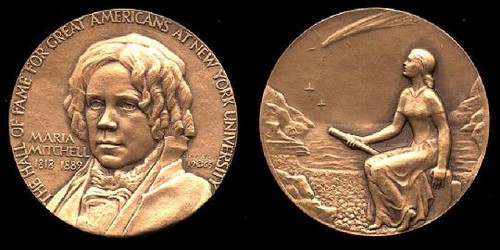
A TRIO OF CIVIL WAR ITEMS FROM 1861
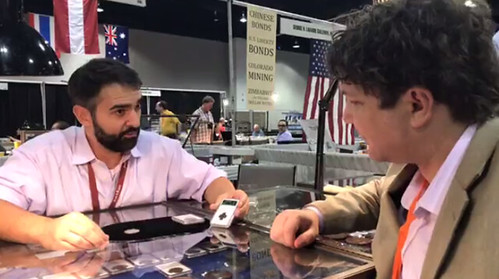
Kraljevich and Morgan with a Beauregard dime

Gallery of American Traitors Medal (obverse)
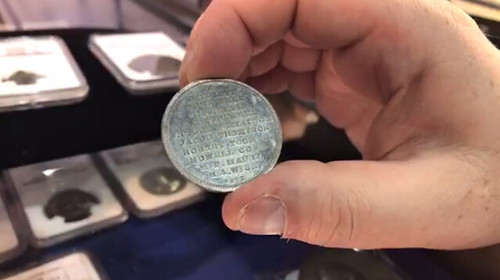
Gallery of American Traitors Medal (reverse)
To read the complete article, see:
Live at the ANA with CoinWeek – A Time of Traitors with John Kraljevich
(http://www.coinweek.com/us-coins/live-ana-coinweek-time-traitors-john-kraljevich/)
To view other CoinWeek Denver ANA videos, see:
Live at the ANA with CoinWeek – Harlan Berk Talks About the 100 Greatest Ancient
coins (http://www.coinweek.com/ancient-coins/live-ana-coinweek-harlan-berk-talks-100-greatest-ancient-coins/)
Live at the ANA with CoinWeek – Pete Smith, Joel Orosz, Leonard D Augsburger
talk about about 1792 coins (http://www.coinweek.com/us-coins/live-ana-coinweek-pete-smith-joel-orosz-leonard-d-augsburger-talk-1792-coins/)
Live at the ANA with CoinWeek – Talking with Andrea from “The Coin Couch”
(http://www.coinweek.com/coin-shows/live-ana-coinweek-talking-andrea-from-coin-couch/)
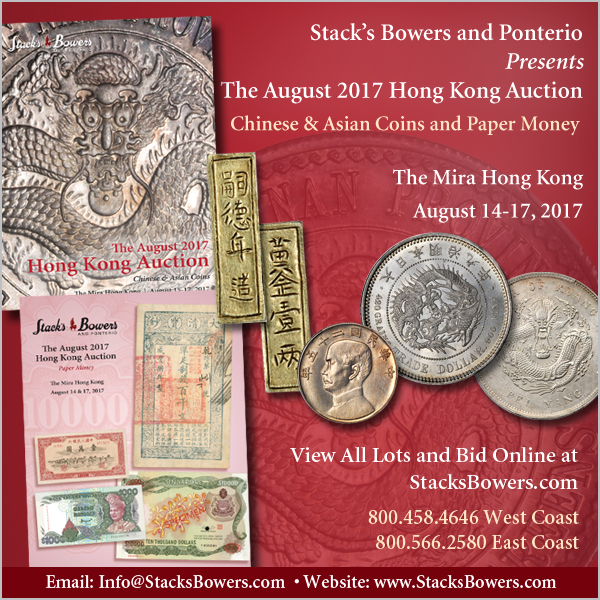
MORE ON THE 1958 JUDAEA LIBERATA MEDAL
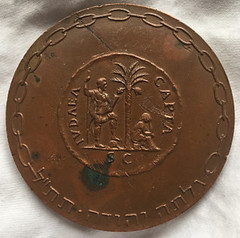
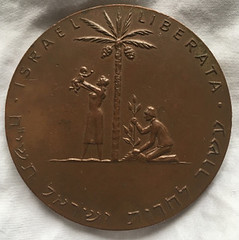
I enjoyed the excellent description and explanation of the 1958 Judaea Liberata medal by Llewelyn Morgan of Brasenose College, Oxford in The E-Sylum of July 9. However, one detail was overlooked by the person who translated the Hebrew inscriptions.
About the modern side of the medal the author correctly explains that "the inscription, which uses Latin to answer the Latin of the Roman coin, ISRAEL LIBERATA, “Israel having-been-freed,” and in Hebrew (again, I am reliably informed) reads “Ten years for the freedom of Israel”, [is] followed by a date in the Jewish calendar corresponding to 1958."
About the inscription on the ancient side of the medal the explanation is that "the Hebrew at the bottom reads (my informants tell me), “Judea went into exile.”" The author's informants did not pay attention to the Hebrew characters following those words. These characters are the date in the Jewish calendar corresponding to 70 CE.
The date on the modern side is 718, short for 5718 (corresponding to 1958 CE). The date on the ancient side 830, short for 3830 (corresponding to 70 CE, the year in which the Second Temple was destroyed). In Hebrew dates the thousands are usually omitted, the exception being the Israeli coins issued from 1981 onwards.
To read the complete article, see:
THE 1958 JUDAEA LIBERATA MEDAL (http://www.coinbooks.org/v20/esylum_v20n28a26.html)
TRUMP AWARDS VIETNAM SOLDIER'S MEDAL OF HONOR
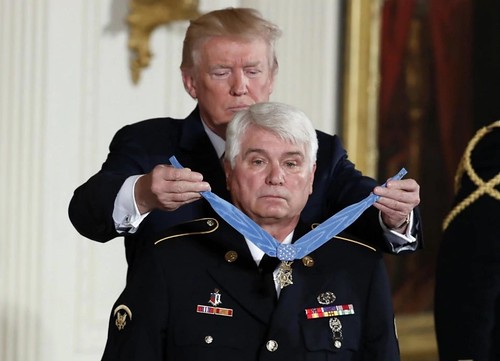
President Trump on Monday presented the Medal of Honor to an Army veteran who 48 years ago repeatedly risked his life to save 10 fellow soldiers during a deadly, days-long fight along Vietnam’s central coast.
In recognizing James McCloughan, now a 71-year-old retired teacher from Michigan, Trump recounted a gripping tale of selflessness and bravery, sliding off script occasionally to emphasize just how hellish the battle was and to marvel that McCloughan and the other Americans who survived managed to overcome such extraordinary odds.
“He was one of 32 who fought until the end,” the president said, glancing at McCloughan, who stood stoically a few steps to Trump’s right, “and they held their ground against more than 2,000 enemy troops. Jim, I know I speak for everyone here when I say we are in awe of your actions and your bravery.”
The brief but poignant White House ceremony marked the first time that Trump has presented the nation’s highest combat award. Among the attendees were 10 men who fought alongside McCloughan at Tam Ky in May 1969, including five whose lives the former combat medic is credited with saving, Trump said.
McCloughan did not speak during the White House ceremony. But when Trump motioned to the former soldier’s Army buddies and asked them to stand and be recognized, McCloughan turned to them and raised his hand in a crisp salute.
As the ceremony came to a close, he and Trump embraced. Amid the applause, McCloughan pointed to several friends and family members in attendance.
The president beamed.
A blessing was offered by the attending chaplain, and the two men hugged once more. McCloughan pulled the president close and spoke into his ear. It is unclear what was said, but in response Trump looked at him and appeared to nod in affirmation.
To read the complete article, see:
A soldier survived
48 hours of terror in Vietnam. He just received the Medal of Honor.
(https://www.washingtonpost.com/news/checkpoint/wp/2017/07/31/a-soldier-survived-48-hours-of-terror-in-vietnam-today-he-receives-the-medal-of-honor/?utm_term=.7c343f296c13)
GOLD COAST GUARD LIFESAVING MEDAL AWARDED
 A local hero who died saving the lives of two teens is being honored with a rare medal.
A local hero who died saving the lives of two teens is being honored with a rare medal.
A year ago, Rodney Buentello didn’t hesitate to dive into the rushing waters of the Medina River to save the girls.
Eyewitness News reporter Karen Grace was at Monday morning's Coast Guard’s “Golden Life Saving Medal” ceremony.
Wearing her son's ashes around her neck, the mother of Rodney Lee Buentello accepted the rare honor with her husband, Buentello’s two sons, and widow by her side.
“It’s been a year since it happened,” Lisa said. “But every ceremony never gets easier.”
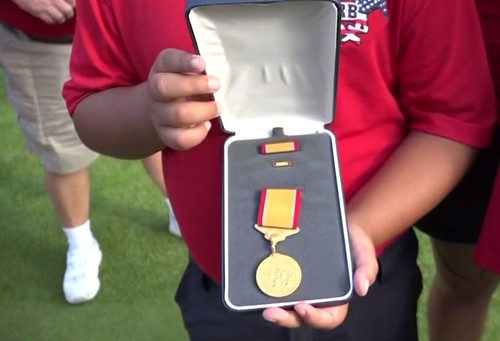
Her son proudly held “The Gold Lifesaving Medal” which is one of the nation's oldest honors.
He and his brother witnessed their father's bravery. They were there when their dad dove into rushing waters. “He saved two people,” described the youngster.
On the Medina River June 8th, 2016, his father answered the screams of two teenage girls. He saved them from the rivers strong undertow, but lost his life in the rescue.
“The bar is very high for this award,” described Rear Adm. Dave Callahan. “It says extreme and heroic daring is specific criteria for this award."
Created in 1874 only for individuals who rescue a person at the risk of his or her own life, the Coast Guard doesn't give out very many.
“It has been in existence for 143 years, we’ve only given it out 728 times,” added Callahan.
To read the complete article, see:
Good Samaritan's family honored with "Gold Life Saving Medal"
(http://www.kens5.com/news/local/good-samaritans-family-honored-with-rare-gold-life-saving-medal/460787989)
To read the earlier E-Sylum articles, see:
GOLD LIFESAVING MEDAL OF THE FIRST CLASS (http://www.coinbooks.org/esylum_v19n19a13.html)
MORE ON THE GOLD LIFESAVING MEDAL OF THE FIRST CLASS (http://www.coinbooks.org/esylum_v19n20a18.html)
WHAT MONEY SAYS ABOUT PEOPLE
We live in a dirty world. Wherever we go, we are among microbes. Bacteria, fungi and viruses live on our phones, bus seats, door handles and park benches. We pass these tiny organisms to each other when we share a handshake or a seat on the plane.
Now, researchers are finding we also share our microbes through our money. From tip jars to vending machines, each dollar, passed person to person, samples a bit of the environment it comes from and passes those bits to the next person, the next place it goes.
The list of things found on our dollars includes DNA from our pets, traces of drugs, and bacteria and viruses that cause disease.
The findings demonstrate how money can silently record human activities, leaving behind what are called “molecular echoes.”
In April, a study identified more than 100 different strains of bacteria on dollar bills circulating in New York City. Some of the most common bugs on our bills included Propionibacterium acnes, a bacterium known to cause acne, and Streptococcus oralis, a common bacterium found in our mouths.
The research team, led by biologist Jane Carlton at New York University, also discovered traces of DNA from domestic animals and from specific bacteria that are associated only with certain foods.
A similar study recovered traces of DNA on the keypads of automated teller machines, or ATMs, reflecting the foods people ate in different neighborhoods. People in central Harlem ate more domestic chicken than those in Flushing and Chinatown, who ate more species of bony fish and mollusks. The foods people ate transferred from fingers to touch screens, where scientists could recover a bit of their most recent meals.
Identifying foods that people eat or the drugs people use based on interactions with money might not seem all that useful, but scientists are also using such data to understand patterns of disease.
Money laundering
Disease transmission linked to money is rare, and no major disease outbreaks have started from our ATMs. Although it doesn’t seem common for diseases to transmit through money, there are ways we
could make our money cleaner.
Researchers are working on ways to clean money between transactions. Putting older bills through a machine that exposes them to carbon dioxide at a specific temperature and pressure can strip dollar bills of oils and dirt left behind by human fingers, while the heat kills microbes that would otherwise linger.
Where's George?
Even if our money is not directly responsible for spreading disease, we can still use the dollar’s travel history to track how we spread disease in other ways. WheresGeorge.com, a website created in
1998, lets users track dollar bills by recording their serial numbers. In the almost 20 years since the site’s creation, WheresGeorge has tracked the geographic locations of bills totaling more than
a billion dollars.
Now, physicists at the Max Planck Institute and University of California at Santa Barbara are using data from WheresGeorge to track epidemics. Information on human movement and contact rates from WheresGeorge was even used to predict the spread of the 2009 swine flu.
To read the complete article, see:
There are
a lot of gross microbes on a dollar bill
(https://www.washingtonpost.com/national/health-science/there-are-a-lot-of-gross-microbes-on-a-dollar-bill/2017/07/28/ba98566e-5b4e-11e7-9fc6-c7ef4bc58d13_story.html?utm_term=.f6be669417cd)

